#literally a 2 second sketch between revision
Explore tagged Tumblr posts
Text

they’re besties your honour
hc of Bicks and Freed when they were younger and Freed definitely wasn't forced to be there
non-colour version:

#fairy tail freed#fairy tail bickslow#fairy tail#freed justine#theyre meant to be kids if u couldnt tell#not entirely happy about how bickslow came out but whatever lmao#literally a 2 second sketch between revision#fairy tail freed justine
39 notes
·
View notes
Text
[INTRODUCTION]
WELCOME TO TRANSFORMERS: BOLD BRIGHT BRISK!
So, since I was super indecisive about which side-plot I wanted to focus on the most, I just made two extra. Yes, all three sideplot story stuff will be posted on this blog.
They all coincide with each other in some way, some events will happen before one sideplot’s events, and others will happen after one other sideplot’s events, so on and so forth.
[TF Media Referenced]
- Rescue Bots Academy
- Rescue Bots
- Transformers Prime
- Robots In Disguise
- Cyberverse
- Last Bot Standing
- More Than Meets The Eye
- Lost Light
- Literally any other miscellaneous information I find on TF Wiki that I insert to fill a couple plot-holes, but aren’t significant enough for me to completely take inspiration from that specific medium
[Overview]
- The war was over between Autobots and Decepticons, and afterwards it was a big celebration while the rebuilding of Cybertron took place. Years after the reconstruction of Cybertron, and it’s newly revised government, there are now many more individual situations that have arisen from the aftermath.
[Asks]
1) Can Accept ✅
- Asks about the lore and characters are very much appreciated!
- I’m also open to do some small sketch requests that pertain to the characters in my Fan Continuity, and characters that are in it but aren’t explicitly mentioned.
- I might answer a few questions with a doodle if I really feel like it, but rest assured I won’t be able to do all of them.
- Oh, don’t worry if your ask sounds a bit “spoilery” I’ll let you know.
2) Won’t Accept ❌
- Sorry, this blog isn’t for role playing with the characters.
- Also any asks that have links to anything without a description or just look sketchy in general, your ask will get deleted.
- Absolutely under no circumstances will I answer any creepy asks like NSFW or anything 18+, it’s just gross to me.
- No bigotry, racism, sexism, or any kind of LGBTQIA+phobia at all in my ask box.
[Tagging]
#sphny speaks (𖦹<𖦹)•*°⊹
- Any and all rambles, reviews, drabbles, or small updates to keep people informed of any “delays” or just small brain farts that happen throughout my day.
#sphny alternates universe (𖦹ㅁ𖦹)•*°⊹
- Whenever I just start to ramble and just start grabbing random info from other TF franchise continuities and alternate them into my universe without a second thought(or many thoughts, depending…)
#sphny arts (𖦹w𖦹)•*°⊹
- Any and all art I make and post, whether it’d be just a draft, concept art, or art dumps that I draw to support my stories.
#sphny reblogs (𖦹Q𖦹)•*°⊹
- On this blog especially, I would usually reblog something from my main, or just self-reblog from my early works, and maybe occasionally something neat I would to add to my blog later on so I don’t forget.
#sphny answers (𖦹0 𖦹)•*°⊹
- Along with asks, I’ll be tagging anything I’ve answered under this tag, just for consistency’s sake.
#sphny originates character (𖦹▿𖦹)•*°⊹
- This rarely ever happens, but on occasion if I were to make an original character I’d make sure to tag it under this so I can be able to track it down easier.
#sphny speaks (𖦹<𖦹)•*°⊹#sphny alternates universe (𖦹ㅁ𖦹)•*°⊹#masterpost#transformers bold bright brisk#tf fan continuity#transformers#maccadam#maccadams#transformers roll call rescue recruits#transformers reach out to reassemble#transformers radiance in disguise
9 notes
·
View notes
Text
Early Original Brown Grover called Gleep and Kermit, others.

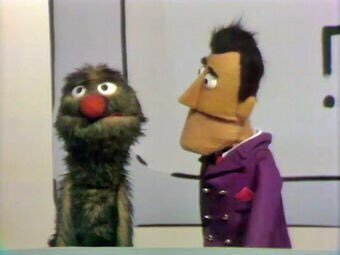

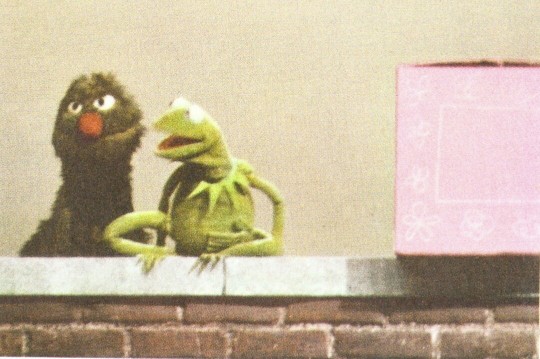


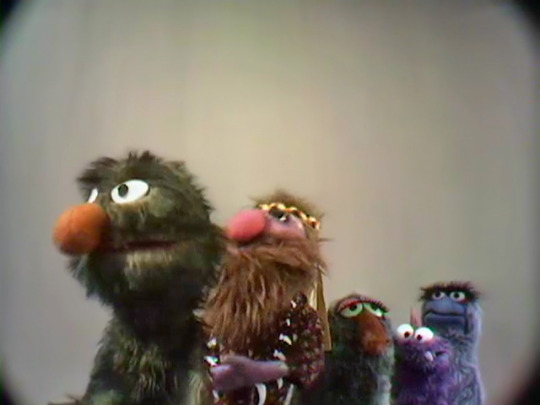



Fuzzyface is a name that has been unofficially given to an early version of Grover by fans. The name derives from a comment made by Kermit the Frog in a first season sketch of Sesame Street. The term "fuzzy face" was actually just a smug remark made by Kermit about the then-unnamed monster because he literally had a fuzzy face. In the same sketch, Kermit calls him "the hairy one" in a similar fashion (the monster also calls himself the hairy one). In another sketch, in which Kermit has Grover bring over nine blocks, Kermit similarly refers to the monster by a number of different terms, including "the hairy monster", "the furry one", and "the fuzzy one".
The term "fuzzy face" was also used by Herry Monster in reference to Cookie Monster during the second season version of Up and Down and by Floyd Pepper towards Animal in episode 222 of The Muppet Show.
The season one pre-cursor to Grover (previously seen on The Ed Sullivan Show as a monster named "Gleep") was performed by Frank Oz, just as the established Grover would be, but his appearance and mannerisms were somewhat different. His design consisted of a greenish-gray fur, and a slightly gruffer looking face. Oz also used a raspier voice for the character, and played him a bit more unkempt than Grover would later behave, certainly without any of the sweetness or consideration for others. Still, even in the first season, some characteristics of Grover could be seen, such as getting simple things wrong, being stomped on or exhausted, and slapping Kermit on the back. A number of sketches with this early "proto"-Grover were later remade with the more familiar blue Grover, including the "first and last" sketch, a sketch where Kermit has Grover count blocks, and the well-known "Near and Far" sketch.
Due to the differences between the season one Grover and the later Grover, who premiered in season two, fans applied the name "Fuzzyface" to his season one appearances based on the "fuzzy face" comment - creating an unofficial new persona designation for the character. However, Sesame Workshop considers this green character to have been Grover, despite not gaining the name until season two. In its 35th anniversary board game, one trivia question reveals that Grover was originally green, suggesting that these characters are the same, albeit models of the evolution of the character. Additionally, sesamestreet.org has "Old Grover" as a tag in the "First and Last" sketch from the first season (although the character has an orange nose in that sketch).
In 2013, the original Grover puppet from 1967 was donated to the Smithsonian Institute. During restoration of the puppet, Bonnie Erickson, executive director of The Jim Henson Legacy, referred to the puppet as "old Grover."
This original "proto"-Grover puppet appeared with the revised Grover puppet at the end of the "What Kind of Fool Am I?" sketch on The Ed Sullivan Show in 1970 and was used in a Season 2 sketch, given a wig and a dress, to become Grover's Mommy.
358 notes
·
View notes
Text
Rainbow Raver: An analysis
Alrighty guys, let me start this off with a quick note: Nothing about this post is in defense of Isaac Larian, the CEO of MGA Entertainment- Isaac’s tweets and accusations at Amina of StudioMucci are objectively indefensible and laced with racially charged insults. I’ve pretty much always thought of him as a shit person so he can get fucked and I have no desire to even think to defend him. This post is entirely about Amina Mucciolo and whether or not the LOL Surprise doll Rainbow Raver (from Hairgoals wave 2) could have potentially been based off of her work- more specifically her hairstyle- and if she is, is that wrong or even legal? Full analysis below the cut (it’s long as hell)
Let’s get started. Amina Mucciolo’s first post with the hairstyle in question was on November 23rd, 2018 (this being the first time she had ever posted with this exact color scheme, as per the caption of the post):

As per the Amazon listing description for Lol Surprise Hairgoals Wave 2, the collection’s official release date was June 12th, 2019:

This collection had also leaked in early June, prior to the official release on Amazon, both via Taobao listings and by Target releasing a few cases prior to the street date on accident. In doll and toy design, it typically takes 12 months or more to take a doll from the original concept sketch----> production and retail sale. There are less than 6 months between Amina’s first post and the official release of Hairgoals Wave 2 on Amazon, fewer if you account for the actual manufacturing times and the leaks prior to official release. In order for MGA to have stolen Amina’s hairstyle for Rainbow Raver, they would have had to:
-Start an original design sketch -Proof and revise the sketch multiple times -Create a physical prototype of the design
-Source the materials and choose the colors of Rainbow Raver’s hair and clothing, then approve a factory sample out of potentially hundreds of samples
-Then finally, mass manufacture the doll for retail sale. Something else to note is that Rainbow Raver is one of TEN dolls in Hairgoals Wave 2:
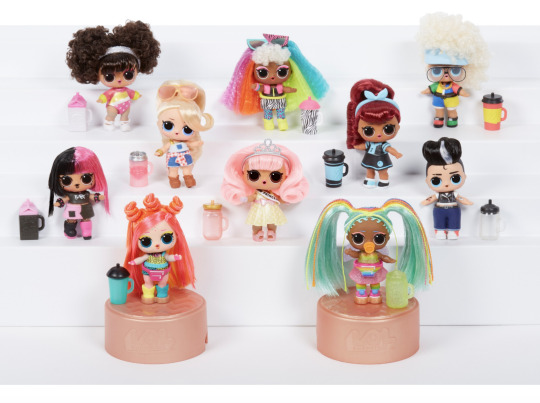
In order for MGA to have stolen Amina’s hairstyle for use in Hairgoals Wave 2, they would have had to stall the release of the other nine dolls, which all come in a single case, with the exception of EDM BB- the doll sitting next to Rainbow Raver- which was the Ultra Rare doll of the line and only came in every second case. Rainbow Raver, however, was sold in every single case of Hairgoals 2. (I would know, I got 4 of her out of 6 individual Hairgoals capsules I ordered on Amazon in June of 2019 lol) In order for them to stall the release, which was timed alongside several other LOL Surprise releases for Fall, they would have had to risk losing several million dollars and push back every other release for 2019- thus throwing off their entire release and production schedule, and potentially ruining their relationship with retailers by not providing the stock they ordered on time.
It is logistically impossible that MGA would have been able to steal Amina’s hairstyle and produce a doll in 6 months, then insert her into a collection of nine other dolls.
But wait, there’s more. In July 2019, MGA released the next collection of LOL Surprise dolls- The Winter Disco Lils collection:
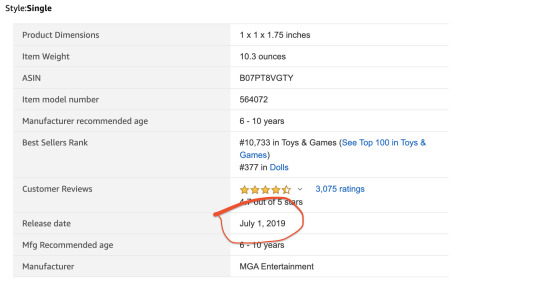
This collection was comprised, almost entirely, of lil siblings for the dolls in Hairgoals wave 2..including Rainbow Raver’s Lil Sister:


So not only would MGA have had to delay the release of Hairgoals wave 2 in order to manufacture a doll based on Amina Mucciolo, they also would have had to delay the release of Winter Disco Lils- which I’ll also note, is one collection in a 4-part Winter Disco line for 2019, which also would have been delayed had MGA stolen Amina’s likeness for a single doll.
IN CONCLUSION: It is quite literally impossible for MGA to have stolen Amina’s likeness for this doll in the timeline needed for this to have happened, both from a production standpoint and a financial one.
---------------------------------------------------------------------------------------
Now! Let’s take a look at MGA’s design portfolio to see how they could have produced this doll without Amina’s hair as a reference:
In 2004, the Bratz Tokyo A Go Go line was released:

This line features colorful fashions, references to Japanese pop culture and....multicolored micro braids, even in pigtails:

I happen to have this entire collection and every doll has multicolored micro braids rooted into their hair, but I’m going to cite Fianna since her hair is the most similar to Rainbow Raver’s in that the micro braids are placed in the exact same manner- symmetrically rooted across the middle of her parting:

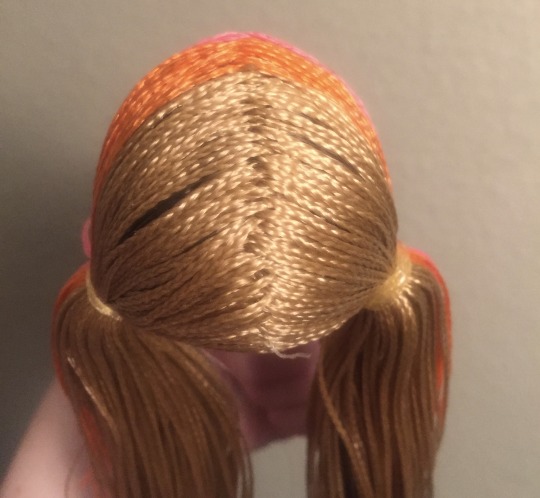
And Rainbow Raver’s hair:

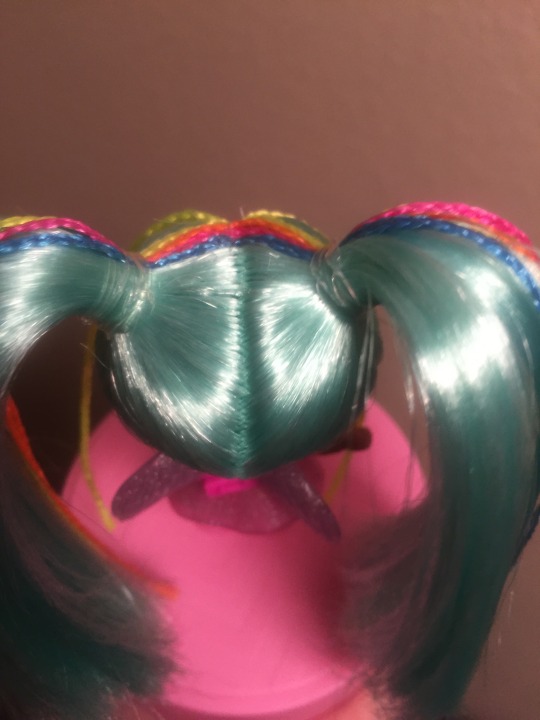
One thing to also note is that Fianna also comes with two braids hanging loose by her face; this is notable on the stock pictures of the doll (I pulled the tendrils back on mine).
Now let’s look at some other MGA dolls through the years with similar design features, to establish that Rainbow Raver’s aesthetic is incredibly common for MGA dolls. I’m gonna go with the most notable ones because jeez there’s a lot. Bratz Live in Concert (2005):
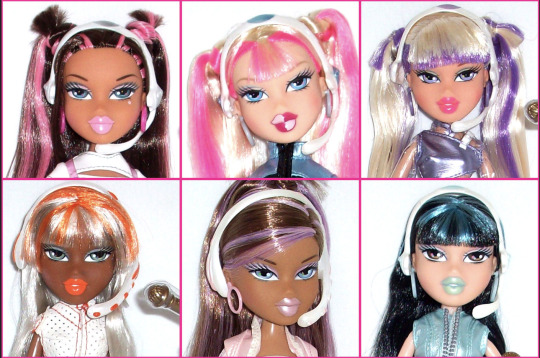
Photo credit to Max on Flickr Brightly colored streaks, references to Japanese pop culture, pigtails. Bratz Action Heroez (2013):

Bratz Twisty Style (2013):


Bratz Study Abroad Cloe (2016):

Note the colorfully-streaked pigtails and clear vinyl skirt, which is also a design featured on Rainbow Raver’s outfit:

Bratz Music Festival Vibez Jade (2016):

Yet another vinyl skirt, rainbow leggings, reference to music festival clothing (which is what Rainbow Raver is inspired by)
Also to note is that this collection was designed by some of the the same people that are currently on the LOL Surprise team.
LOL Surprise Hairgoals Wave 1 Splatters doll (November 2018):

Rainbow Surprise doll: Rainbow Dream (2019):

Rainbow Dream features a hairstyle based in teal, with rainbow streaks throughout:
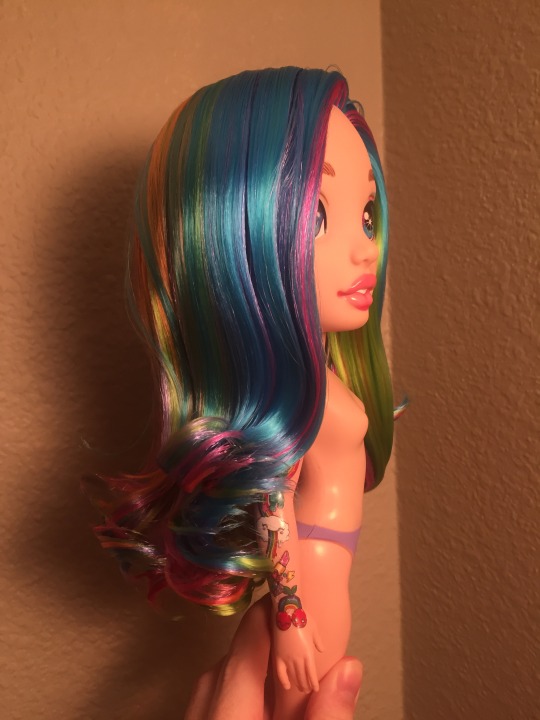
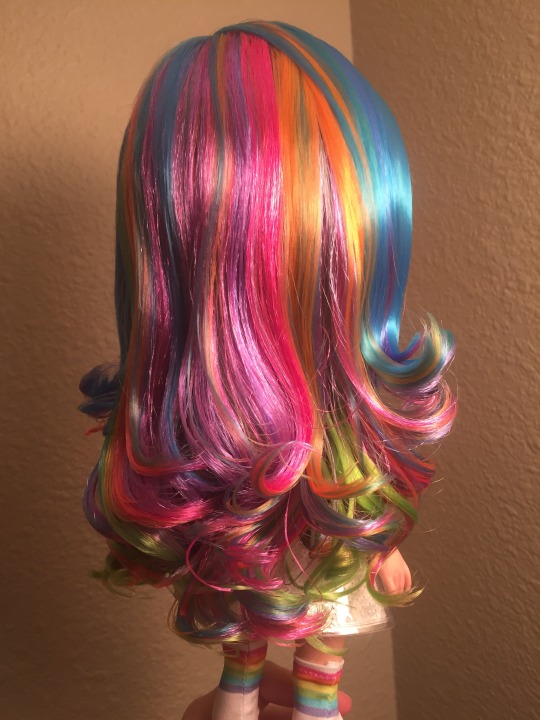
Clearly, rainbow streaks, micro braids and pigtails and rainbow striped clothing have been staples in MGA’s designs for well over a decade at this point. So now that we’ve established that it’s all but impossible for MGA to have stolen Amina’s likeness for this doll, let’s ask:
Do companies use real-life people and artwork as inspiration in the design process?
I can tell you now, with absolute certainty, that toy companies DO use pictures of real people and artwork as inspiration and references for designs...just as almost every other company does, and that includes Studio Mucci.
Whether you think it’s wrong to use outside inspiration when designing a product or piece of artwork is up to you. I’m inclined to think you probably don’t think it’s wrong, unless you believe that everything you love, every TV show and every piece of artwork, came from a vacuum without external inspiration and references. It totally didn’t by the way.
Is it legal to use outside inspiration, including photos of real people, as references for product design?
Unless the product point-blank copies a trademarked logo or design, yes.
None of the featured similarities between Amina and Rainbow Raver can be trademarked or copyrighted, and Amina cannot claim teal hair with rainbow streaks, or rainbows in general, as her Intellectual Property.
I’m going to end this post by saying that I feel for Amina. Black creatives are so often stolen from, undervalued and ignored, and it’s frankly irresponsible to expect a normal person to know this much about toy design schedules, and it’s even more irresponsible to expect a normal person to have a catalogue of every MGA toy release logged in their mind- heck even most doll collectors don’t think about this stuff.
And once you add in that MGA had hired her to do content for them, that even further cements the belief that they’d stolen her work.
But no matter how easy it is to believe that’s what happened, it’s factually impossible and Amina was just wrong on this one.
I think the official LOL Surprise statement was sufficient at providing a basic design timeline for people that probably don’t understand how long it takes to make a doll, and was incredibly respectful of Amina’s work and humanity.
Isaac Larian’s subsequent comments were disgusting, racist, and completely lacking in empathy for Amina’s feelings.
I hope Amina can move on from this, and that Isaac Larian learns to keep his big mouth shut- at least, after he issues a public and private apology to Amina personally, considers making a sizable donation to BLM to make up for the horrible things he said.
Thanks for reading.
68 notes
·
View notes
Text
subfluence merged in an ornamental lake
but these very subfluences 1 subfluence over boundaries or lands 2 subfluence which natural causes have on the limity of the reflection 3 subfluence, recording occurrences 4 subfluence over ennui. I had not the 5 subfluence. What do we do? What does the 6 subfluence, discoverable or unexplained 7 subfluence, at nights 8 subfluence in production or waste, used freely 9 subfluence literally incalculable, the principle on which 10 the heart-beat is subfluence. 11 subfluence diffused 12 subfluence full of romance 13 lies, and other caustic or irritant subfluence 14 subfluence, the signaling, the adjustment of huge mechanisms 15 subfluence merged in an ornamental lake 16 subfluences subdued 17 his special subfluence, for he was an omnivorous reader, and had a picturesque and even romantic outlook on 18 subfluence, with the colors still 19 subfluence the entire cotton trade 20 subfluence spread far and wide. 21 subfluence, the possibility of human flight 22 subfluence for lack of language : error 23 Subfluenz-Prozesse 24 Subfluenz, einer varistischen 25
sources (most, and mostly OCR misreads)
1 OCR misread for “substances,” at “Of points wherein we and Papists differ, viz., Transubstantiation, &c.,” in John Rawlet (1642-86 *), A dialogue betwixt two Protestants, in answer to a Popish Catechism (Third edition, corrected; London, 1686) : 82 2 ex “A sketch of the life and public services of Gen. William Henry Harrison.” in (Isaac Rand Jackson?), General William Henry Harrison, Candidate of the People for President of the United States (Baltimore, 1840) : 6 Harrison (1773-1841) would have a short (31-day) tenure as president, but had done enough damage in previous roles, particularly with regard to indigenous people. see wikipedia 3 ex “Scripture and Geology” (by N), in The Mirror of Literature, Amusement, and Instruction (Saturday, August 14, 1841) : 99-103 (100) see wikipedia for its publisher John Limbird (1796?-1883) 4 ex “Druids and Bards,” being an extensive notice/review of three books — J. B. Pratt The Druids Illustrated (1861), John Williams, ed., Brut y Tywysogion (1860), and Godfrey Higgins, The Celtic Druids (1829), in The Edinburgh Review, 118 (American Edition; July 1863) : 20-36 (35) 5 ex “A Rolling Stone.” By George Sand, translated from the French by Carroll Owen, in Library of Famous Fiction 2 (1879) : 1-113 (109) 6 OCR cross-colum misread, involving M. H. Cobb, “Common Sense Applied to Living” (pp 5-7) and “A Parlor Drama, in Two Acts” by Augusta De Bubna (pp 7-13), in The Brooklyn New Monthly Magazine, Henry Morford (1823-81), editor and manager; 1:1 (January 1880) : 7 7 ex A. Ernest Sansom, “The Dyspepsia of Infancy,” in The New York Medical Times 19:2 (May 1891) : 33-37 (34) 8 involving obituaries (memorials) for James Holmes and David Wright, in the section “Connexional Biography” in The Primitive Methodist Magazine 73 - London, 1892) : 51 on “Connexionalism” (and its relation to “network”), this, from wikpedia — “The United Methodist Church defines connection as the principle that ‘all leaders and congregations are connected in a network of loyalties and commitments that support, yet supersede, local concerns.’ Accordingly, the primary decision-making bodies in Methodism are conferences, which serve to gather together representatives of various levels of church hierarchy.” 9 ex “Brief Gleanings : The treatment of Leanness and Obesity” in The Medical Brief (A Monthly Journal of Scientific Medicine; J.J. Lawrence, Proprietor) 20:10 (St. Louis, Mo; October 1892) : 1240 10 ex W. Garden Blaikie, “St. Paul’s Pastoral Counsels to the Corinthians.” in Exegetical and Expository Section, The Homiletic Review 29:5 (May 1895) : 451-453 11 Aloysius O. J. Kelly, “Essential Paroxysmal Tachycardia — Report of Four Cases.” (Read October 14, 1896), in Proceedings of the Philadelphia County Medical Society 17 (Session of 1896) : 166-180 (171) Kelly (1870-1911) obituary at Boston Medical and Surgical Journal (now NEJM) March 9, 2011) : 360 12 out of chronology (and unlinkable snippet, only), mea culpa, ex The Evangelical Magazine and Missionary Chronicle 21 (1813) : 328 13 snippet only, evidently from Chapter 9 “Signs and Tokens” of Charles Dickens, Bleak House (1852-53), here ex Works Volume 3 (1899) : 374 14 misread involving “Milk a Universal Antidote” and “School-Meals for Underfed Children” in The Dietetic and Hygienic Gazette (A monthly journal of physiological medicine) 16:1 (January 1900) : 20 15 ex Edward Nelson, “Electricity in Service on British Battleships,” in Electricity 29:23 (December 6, 1905) : 311-313 16 preview snippet only, at (Commonwealth of Australia) Parliamentary Debates 57 (1910) : 3207 17 ex index of volume, Proceedings of the American Society for Psychical Research (Section “B” of the American Institute for Scientific Research) vol. 5 (New York, 1911) : 771 18 ex entry (by “C. L. G.”) for Meredith White Townsend (1831-1911), in Dictionary of National Biography, edited by Sidney Lee. Second Supplement vol. 3, Neil – Young (New York, 1912) : 532 19 preview snippet only, ex The American Year Book 5 (1915) : 300 20 § 816. Corners... in William Herbert Page, The Law of Contracts Second edition; revised, rewritten and enlarged with forms. Volume 2. (Cincinnati, 1920) : 1441 21 ex “Balboa Day, September 17th, 1919 in Honolulu,” in Bulletin of the Pan-Pacific Union (January 1920) : 6 22 misread, involving report on “The Langley Flying Machine” (and some controversy between S. P. Langley and the Wright brothers), and “The Impurity of Pure Substances” (review of A. Smits, Theorie der Allotropie (1921)) in Nature 108 (November 3, 1921) : 298 23 misread, involving Booth et al v. Floyd (No 2358) and Blackstone v. Nelson, Warden (No 2457) in The Southeastern Reporter 108 (August 27 - December 3, 1921) : 114 24 H. J. Behr, “Subfluenz-Prozesse im Grundgebirgs-Stockwerk Mitteleuropas.” Zeitschrift der Deutschen Geologischen Gesellschaft 129 (1978) : 283-318 25 K. Weber, “Das Bewegungsbild im Rhenoherzynikum Abbild einer varistischen Subfluenz.” Zeitschrift der Deutschen Geologischen Gesellschaft 129 (1978) : 249-281 referring to the Variscan Orogeny (wikipedia)
method
1
There is no word “subfluence,” or only barely one. This started with the self-written biographical note of poet Jack Hirschman, in A Caterpillar Anthology (Clayton Eshleman, ed., 1971) —
“They are lyrical poems, in verse or free-form, as distinguished from the poems in this anthology, which are breath forms reflecting a more total slavery to the conditions of the spirit’s war-torn years. The major influences on my works are influence itself, in as many levels of order, disorder, disaster, paranoia, joy and ecstasy as the deathless magic of being alive permits a vessel now of fire, now of air, to spark, glow, flame and ember according to the law of nature.”
“Influence” — that word — led to thinking about variations, e.g., effluence, outfluence, pre-fluence... “subfluence” — an underground stream a less-than fluency (stammering, stuttering) a brittleness?
Little — or nothing — surfaced in a google books search, save for errors — typically a “sub” at the end of one line, a “fluence” at the start of the next (in a different column). Quite enough for present purposes. And so these subfluence derivations are built around a word that isn’t quite a word. Some license has been taken with the text in this post: dispensing ellipsis or [brackets] where text is erased (or rather, dropped); in some instances, some words that preceded the subfluence, are moved to follow it.
2
And yet, the word does appear, in some (and only a few) geological texts, typically having to do with the geotectonic unterströmungshypothese (undercurrent) concepts — and field work done in the Northern Calcareous Alps — of and by Otto Ampferer (1875-1947). More on Ampferer to come. For now, these references —
Wolf-Christian Dullo and Fritz A. Pfaffle, “The theory of undercurrent from the Austrian alpine geologist Otto Ampferer (1875-1947) : first conceptual ideas on the way to plate tectonics,” Canadian Journal of Earth Sciences 56 (2019) : 1095-11 here
Karl Krainer und Christoph Hauser, “Otto Ampferer (1875–1947): Pioneer in Geology, Mountain Climber, Collector and Draftsman,” in: Geo.Alp Sonderband 1 (2007) : 91–100 here (pdf)
wikipedia (in German)
Dr. Otto Ampferer. “Über das Bewegungsbild von Faltengebirgen” (On the movement pattern of folded mountains), in Jahr. Geol. Reichsanstalt (Yearbook of the Austrian Geological Survey), 56:3-4 (1906) : 539-622 “Mit 42 Zinkotypien im Text” here
3
“Subfluence” also surfaces as a company name, social media handle, &c., &c.
—
all tagged subfluence
5 notes
·
View notes
Text
Nampō Roku, Book 6 (11.2, part 2): the Details of the Go-daisu-sho [御臺子所] in Ashikaga Yoshimasa's Shoin.

11.2, continued) What follows is a sketch that documents this [kind of arrangement]¹.

_________________________
◎ The way that the notes have been written on the illustration is frequently very confusing. I will try to make better sense of things, for the reader, by redrawing the sketch, and separating the text from the sketch completely (with the notes referring to points indicated on my drawing by bracketed letters). The somewhat erratic ordering of the notes on the redrawn sketch (below) reflects the confused way in which the details are written on the original sketch (though I have more than once combined fragments that are actually scattered more randomly, since otherwise the descriptions would be unreadable).
¹Hidari ni zu wo shirushi to domu [左ニ圖ヲ記シトヾム].
Hidari ni [左に] means “on the left.” The sketch follows this section of the text, with was written right to left.
To domu [トヾム] is most likely a corruption (as a result of deterioration of the paper)* of to iu [と云], which means something like “so it is said.” ___________ *Tanaka Senshō’s teihon [底本] has to iu-iu [ト云〻]; while, once again, Shibayama Fugen agrees with the Enkaku-ji manuscript by concluding this sentence with to domu.
In both this case, and the one cited in the last footnote in the previous post (where the kanji kyaku [客] and miya [宮] were confounded), the discrepancies can be explained by physical deterioration of the paper on which the text was written. Tanaka’s interpretation may have been the result of scholarly inquiry, rather than deterioration between the time when his source copied down the text and when the Enkaku-ji manuscript (and Shibayama’s teihon) were produced.
Consequently, the present issue tends to support the argument that the previous sentence was also corrupt.
==============================================
◎ The sketch of the south-facing shoin in the Higashiyama-dono’s palace.

Ⓐ Mi-chōdai [御調臺]².
Ⓑ Above this is [suspended] a mizu-hiki [水引], [tied up] with age-maki [アケ巻]³.
Ⓒ 2-ken-wide oshi-ita toko [押板床]⁴.
Ⓓ Jō-dan [上段], 6-mats⁵.
Ⓔ Shōji [障子]⁶.
Ⓕ Small wood-floored room, with a latticed ceiling; the room was finished with imported wood⁷.
Ⓖ Mi-kutsu-sho [御沓所]⁸.
Ⓗ When tea will be served from the daisu, 2 raised tatami [for the nobleman] are [arranged] here⁹.
Ⓘ Daisu-sho [臺子所], with windows above on the two [adjoining walls]¹⁰.
Ⓙ Four koshi-shōji [コシ障子] panels. The upper [part of the shōji] are kumi-bone [組骨], while the lower [part is finished like] fusuma [with] sunago [paper pasted on both sides]. (These [shōji] are removed when [the tea utensils] are displayed on the daisu.)¹¹
Ⓚ 2-shaku 6-sun 8-bu high shōji with exposed wooden frames, two panels¹².
Ⓛ Above, wrapping around the daisu-tatami, are [two] windows featuring a diamond pattern¹³.
Ⓜ In this veranda room are spread twelve tatami-mats, including the mat on which the daisu is displayed¹⁴.
Ⓝ Wooden storm-doors, two panels. (This [doorway] is also known as the mo-biki no ōdo [裳引ノ大戸].)¹⁵
Ⓞ Under the windows that face in two directions, a 6-panel byōbu, [covered with paper] decorated with flakes of gold and silver, is stood; perhaps it might also be stood with two panels folded [closed]¹⁶.
Ⓟ [Along this side are a bank of] shōji��⁷.
Ⓠ In this area is the ochi-en [落エン]¹⁸.
Ⓡ In this area is a smooth edging board 5-sun [wide]¹⁹.
〽 This room measures 3-ken by 4-ken²⁰.
==============================================
²Mi-chōdai [御調臺] = mi-chōdai [御帳臺]. The nobleman’s “seat of estate*.” While originally portable (it was taken to wherever the nobleman wanted to be), by this period it was built in at the end of the jō-dan farthest from the entrance to the room. __________ *Also used as his bed, when dining, and possibly when pursuing literary or clerical activities (to the extent that a nobleman would be personally involved with such things) as well.
³Kono ue mizu-hiki, age-maki ari [此上水引、アケ巻アリ].
A mizu-hiki [水引] is a length of cloth suspended from the otoshi-gake [落掛] (the horizontal beam that serves as a base for the transom), and gathered into a series of swags* (rather like ornamental bunting) with cords. The cords (usually with tassels on the lower ends) were tied with an age-maki [総角] knot. The mizu-hiki could be lowered (to shield the interior of the mi-chōdai from the view of those seated on the outside).

An age-maki knot is shown above, while a mizu-hiki suspended along the front of a government check-point (seki-sho [關所])† is shown below.

This detail seems to have been something that became common during the Edo period (a mizu-hiki was often suspended in front of any elevated platform on which government officials were seated -- such as the open-front building that housed the inspectors at the government check points that were erected at intervals along the major highways)‡. The mizu-hiki could be lowered or raised, depending on the preferences of the nobleman who would be seated on the mi-chōdai.
Reference to the mizu-hiki is found only in the Higashiyama-dono o-kazari sho [東山殿御飾書], which is the Tokugawa-sponsored revised version of Sōami's O-kazari ki [御飾記]**. __________ *Sometimes just two, with a single cord in the middle; sometimes into three swags, using two cords.
†The example shown in the photo is the reconstructed Hakone seki-sho [箱根関所], the first major government check-point on the famous Tōkai-dō [東海道], when leaving Edo.
‡In earlier days sudare-like blinds (albeit usually made of finely split bamboo, rather than reeds, and edged with kinran or brocade) were suspended along the open side of the mi-chō-dai. These were often left open (rolled up and then secured with the same sort of age-maki cords), but could also be lowered (permitting the person seated on the mi-chō-dai to see the people seated in the room beyond, while being hidden from their view), at the nobleman's discretion.
**All of these details argue against this being an authentic part of Nambō Sōkei’s notes, which originally made up the contents of Books One, Six, and Seven of the Nampō Roku. (The language of this entry, too, is of the Edo period, rather than the second half of the sixteenth century.)
⁴Ni-ken no oshi-ita toko [二間ノ押板床].
Ken [間] is a unit of length equal to 6-shaku, so two ken (ni-ken [二間]) would equal 12-shaku -- which is the width of this oshi-ita [押板]*.
An oshi-ita was a wood-floored platform, raised a certain distance above floor-level, on which decorative objects were arranged†. One (or a set of two, three, or even more) kakemono was hung on the wall at the back of the oshi-ita, and one (or more) tables were set up in front of the scroll(s), on which incense, candlesticks, and flower arrangements were displayed.
Appending the kanji toko [床] to the expression oshi-ita [押板] (like appending toko to the expression shoin to make shoin-toko [書院床]‡) only appeared in the Edo period. __________ *The expression oshi-ita [押板], “a board pushed [against the wall],” originally referred to a long Korean table (such as were used in the dining halls of Buddhist monasteries) that was pushed against the wall, and on which the various objects were arranged. As a consequence of the expense and nonavailability of such pieces (after trade with the continent was suppressed in the fifteenth century), a built-in shelf of a comparable height came to supplant the actual table, while retaining the same name.
†It was thus the forerunner of the ita-doko [板床], a board-floored tokonoma.
‡Shoin-toko [書院床] refers to the dashi-fuzukue [出し文机], the built-in writing desk (historically speaking, it was only called the tsuke-shoin [付書院] much later) when the objects on it are arranged for display (rather than for use).
While a certain amount of intentional manipulation had been known since earlier times, even in Rikyū’s day the objects were arranged primarily for use (Rikyū, for example, actually made a habit of using his dashi-fuzukue prior to the gathering -- perhaps to write out the page of information for the guests that was traditionally left in the koshi-kake) -- and then left as they were, so they could be inspected by the guests. Deliberately arranging the objects on the tsuke-shoin, while considering it to be just another place where treasures could be displayed (but never actually used), was done at the behest of the Tokugawa bakufu.
Toko [床], which literally means “bed,” was a slang reference to a built-in mi-chōdai. It thus referred to a platform floored with a tatami-mat (rather than a board).
⁵Jō-dan roku-jō [上段 六疊].
Jō-dan [上段] means that this six-mat section of the floor was elevated above the other parts of the reception room (though the mi-chōdai was naturally raised even higher). Only persons of high rank would be invited to sit there (since they would be in close proximity to the nobleman who was ensconced on the mi-chōdai).
⁶Shōji [障子].
Sliding papered panels. Possibly they were papered on both sides (and so would be what are called fusuma [襖] today), though this is unclear (since no description is made -- as it is for the shōji located elsewhere).
This word is not found on all versions of this sketch.
⁷Ishi-datami no kumi-ire kara-ki no ko-itashiki [石疊ノクミ入カラ木ノ小板敷].
Ishi-datami no kumi-ire [石疊の組入] refers to the ceiling: ishi-datami [石疊] means that the ceiling was divided into squares (like a checkerboard) by means of horizontal lattices. A wooden panel was placed above each open square thus created (to hide the underside of the roof above), which is what kumi-ire [組入] means. This kind of ceiling is also called a kumi-ire tenjō [組入天井].
Kara-ki no ko-itashiki [小板敷] means a small, wood-floored room (in this case, apparently equal in size to a 3-mat room). The room was floored with imported (“Chinese”) wood. (Kara-ki can specifically mean ebony.)
This small room was located between the vestibule (where the guests’ wooden shoes were stored) and the jō-dan. While it could have been used as a place for persons of lower rank to sit, the room was finished with high-quality imported wood because the guests who were invited onto the jō-dan would have to pass through it.
⁸Mi-kutsu-sho [御沓所] refers to a vestibule (often with the floor paved with stone) in which the guests’ footwear was stored.
Kutsu [沓] are lacquered wooden rain-shoes (with raised soles and a sort of carved hood that covers the toes).
⁹Go-daisu no toki, koko ni o-age-datami ni mai [御臺子ノ時、コヽニ御上疊二枚].
O-age-datami [御上疊] seems to refer to a low platform on which two tatami (ni mai [二枚]) were placed, as a seat for a nobleman. In fact, this refers to the kind of arrangement that was originally named the mi-chōdai [御調臺] (albeit apparently without the usual surrounding hangings that were incumbent on a mi-chōdai of the original sort).
When tea would be served from the daisu, the nobleman left his mi-chōdai and took his seat on this o-age-datami.
¹⁰Daisu-sho [臺子所]: the mat on which the daisu was set up.
¹¹Yon-mai no koshi-shōji, ue kumi-bone shita sunago no fusuma-shōji, daisu kazari no toki mina hazururu [四枚ノコシ障子、 上組骨 下スナコノフスマ障子 、 臺子ノ時、ミナハツルヽ].
Koshi-shōji [腰障子] are shōji that have a (usually) wooden panel at the lower end. The idea is to protect the shōji from being damaged by the feet of people who are seated along them (this veranda room was used for the seating of the lower ranking attendants of the persons who were received on the jō-dan, and such attendants would usually sit in rows along the sides of the room). Two pair of such shōji were placed along this side of the room, to let light into the large hall (though between the lower pair of pillars, a pair of fusuma were used).
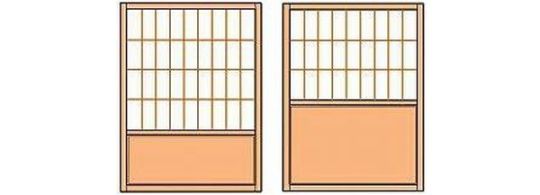
The actual height of the panel is not fixed*, though it is usually around 1-shaku today. Occasionally shōji of this type have a panel that rises to the height of a person's shoulders (when seated on the floor). Shukō’s 2-mat room was said to have had shōji of the latter sort.
Kumi-bone [組骨] refers to a shōji panel that is papered on only one side, while the lattice-work is visible on the other -- and which was intended to allow light to pass through. The upper part of these four koshi-shōji panels were made in this way.
Meanwhile, in the case of these particular shōji, either the wooden panel was covered (on both sides) with sunago-kami [砂子紙]†; or else, rather than a wooden panel, the frame was simply covered on both sides with sunago paper (though this might seem rather dangerous)‡.
When chanoyu was served from the daisu**, the four koshi-shōji that separated the veranda room from the large hall (to its right) were removed. ___________ *Today koshi-shōji are usually distinguished into koshi-tsuki-shōji [腰付障子] (on the left) and koshi-daka-shōji [腰高障子] (on the right).
Unfortunately, nothing is said to indicate the height of the wooden panels in this description.
†Sunago paper is paper on which small flecks of gold or silver foil, or small bits of mica, are scattered.

Usually a heavier sort of paper such as tori-no-ko [鳥の子] was used for fusuma, since the idea of this kind of panel was to keep light from passing through.
‡The lower panels are described as sunago no fusuma-shōji [砂子の襖障子]. This means that the panels were papered on both sides with sunago-kami [砂子 紙]. However, since the purpose of the panel was to prevent damage to the shōji when someone was seated in front of it, and since the veranda room was usually where the lowest-ranking attendants of the guests were seated (with their backs to the shōji), usually with nothing to occupy them whatsoever, this aspect was probably even more important than usual. Thus there was almost certainly a wooden panel inside that was simply disguised by being covered on both sides with the decorative paper.
Fusuma [襖] are made just like shōji, but differ from them in two respects: first, because heavier paper is used (since the purpose is to keep light from passing through); and secondly, because they are papered on both sides.
**The officiant was probably one of the dōbō-shū [同朋衆] (since the service was conducted on the veranda). Yoshimasa would have sat on the 2-mat o-age-datami platform, if he was participating.
¹²Takasa ni-shaku roku-sun hachi-bu, kumi-bone no shōji ni mai [高サ二尺六寸八分、組骨ノ障子二枚].
The shōji were similar to modern-day shōji, where a wooden framework is covered on one side by a thin sheet of paper*, and probably without a wooden panel at the bottom.
The relatively low height of these shōji panels may have been because persons seated on the veranda were not supposed to simply step into the adjoining room through these shōji. (The shōji would require them to go down on their knees and slide over the track, probably with their heads bowed forward. The low height of the kayoi-guchi / katō-guchi [通い口・火燈口] in the tearoom -- the doorway to the preparation area that has a rounded upper edge, and through which food and sweets are brought to the guests -- serves the same purpose of keeping people from walking through it.) __________ *This is the meaning of kumi-bone no shōji [組骨の障子].
¹³Ue ha daisu-tatami oshi-mawashi, hishi no kumi-mono mado [上ハ臺子疊ヲシマハシ、菱ノ組モノ窓].
Though this text is written on the sketch as if it were connected with the previous statement (regarding the low shōji that were described in the previous footnote), it actually refers to a pair of windows in the walls that surround the daisu-tatami on two sides.
Oshi-mawashi [押し回し] means to be pressed, or wrapped around (something). Thus, the windows are being described as “wrapping around” the daisu-tatami.
This pair of windows, which would seem, from the description, to have met at the corner (so that the entire window was shaped like an “┏”) were covered with shōji panels* where the lattices were oriented on a diagonal, resulting in a diamond (hishi [菱]) pattern. These panels would, therefore, contrast with the rest of the shōji that enclose the veranda room. __________ *These had paper pasted on one side only. The paper was generally pasted on the outward-facing side of the shōji because (at least originally) its purpose was to deflect rain (if the wooden lattices face outward, water will collect on the upper sides of the horizontal lattices, loosening the glue that fastens the paper to the wooden frame).
¹⁴Kono engawa daisu-tatami tomo ni tatami jū-ni-mai shikaruru [此エンカハ臺子疊トモニ疊十二枚シカルヽ].
Once again, though it appears that this statement is written as if it were connected with the previous two, this is not the case.
Here the author is simply indicating that this enclosed veranda room (engawa [緣側]) is of 12-mats (including the mat on which the daisu is displayed). While the tatami in modern rooms are usually arranged in “decorative” patterns, in the early rooms there were usually simply laid down in rows.

The arrangement of the mats in this room would have looked like what is shown above.
¹⁵Ōshike fuchi no do ni mai, mo-biki no ō-do to iu [大シケフチノ戸二枚、裳引ノ大戸ト云].
Ōshike [大時化] means a heavy storm.
This seems to refer to wooden doors set in deep tracks (such as were found in the seawalls that protected the warehouses that adjoined the wharves) that would prevent wind and rain from blowing through. A pair of such sliding doors shared the tracks at the end of the veranda room.

A mo [裳] is a ceremonial train*, made of white silk gauze (usually with a design stamped on with gold- or silver-infused lacquer†) worn by women when attending upon a person of high rank. They would tie on the mo (mo-biku [裳引く]) after stepping into the veranda room through this pair of doors (which open onto the carriage entrance)‡.
Elsewhere in Book Six of the Nampō Roku, mo-biki no ō-do is used to mean the host’s entrance -- the katte-guchi [勝手口] or sadō-guchi [茶��口]. __________ *The mo resembles an apron, of the sort that is tied on at the waist. It flairs out slightly from the waistband, and is several meters long. Unlike an apron, the mo extends toward the back, and trails behind the wearer. White Takeya-machi gire was preferred for the mo because it was much less expensive than kinran, and also significantly lighter in weight (which is important on account of its length). Also, white with a pattern in gold would not clash with any of the other colors that the person was wearing -- though, during certain historical periods, the white cloth was dyed to complement the rest of the outfit.
†The series of cloths called Takeya-machi gire [竹屋町裂] were originally used for this purpose. In fact, the cloth that was imported from China was white silk gauze, with an arabesque (or other) pattern stamped on it in gold. This is why the design is usually quite simple and geometric (which minimizes the size of the blocks needed to stamp the design). Below is a photo of an actual piece of Takeya-machi gire.

Reproductions made in Japan, however, usually reduce the patterns, and then render them as kinran [金襴] -- to the extent that modern people do not even realize what the original cloth was like. Note, however, that the way the stamp was cut, “real” Takeya-machi gire actually does look like woven kinran -- unless one looks very close.
I will digress for a moment, because there is a certain amount of confusion connected with Takeya-machi gire. In the Edo period a “rule” arose stating that scrolls written by monks (some versions of the rule specifically state monks affiliated with the Daitoku-ji in Kyōto) -- and (again, according to some) it should not be used when mounting scrolls inscribed by others. The reason for the rule was actually connected with yoko-mono [横物] (horizontal scrolls), many of which were not originally intended as scrolls, but were written to be framed as gaku [額] (framed specimens, very often of calligraphy, that are hung high on the wall, usually suspended above fusuma or shōji). When mounted in this manner, conventional cloth can be used without any special difficulties. However, if calligraphy such as this is mounted as a kakemono, there are problems because most traditional cloth is only 9-sun or 1-shaku wide, and kinran must be cut parallel to the weft (if kinran is cut parallel to the warp, the metal threads will detach at the edge of the ichi-mon-ji and project forward). It is possible to “splice” several sections together to make it appear to be a single piece, though after a time the lines where the sections meet become apparent (and it takes a lot of effort to match the pattern). The pattern on Takeya-machi gire, on the other hand, is stamped on with gold lacquer, meaning that the cloth can be cut in any direction without any subsequent problems. This is why it was preferred for wide horizontal scrolls. Furthermore, since the design is stamped on rather than woven, the cloth was much less expensive than kinran, which was philosophically in keeping with scrolls written by monks.
‡The mo would become horribly wrinkled if worn while riding in a palanquin or some other such conveyance).
¹⁶Kono ni-hō mado no shita, kin-gin sunago-ji no roku-mai byōbu tate, mata ni-mai ori mo tatsu [金銀砂子地ノ六枚屛風立、又二枚折モ立].
As above (footnote 11), sunago-ji [砂子地] means that the paper was lightly covered with flakes of gold and silver foil*.
There is a certain ambiguity regarding how the byōbu will be arranged†, and using a 2-fold screen might seem to be the more logical solution. __________ *Though sometimes mica flakes were used rather than silver, since silver will oxidize to black, while mica will retain its silvery glitter.
†In fact,it is rather difficult to envision a six-fold screen placed only along two sides of the daisu-tatami (if only because the folds would tend to make it project rather far from the wall). This six-fold byōbu is only described, and not delineated in the sketch.
One possibility is that it was arranged as if it were a two-fold screen, with three panels on each side, as shown below.

Another is that two panels extended along the wall on the left side of the daisu-tatami, with four panels along the far wall -- and this may be why two panels are folded up (to limit how far it would project along that far wall and the adjoining pair of shōji).

In this second case, the screen would have to be oriented with what was usually the back side facing toward the room. As a result, the byōbu would have had to be finished in the same way on both sides (at least nowadays, the back side is usually finished with inferior paper).
‡Earlier it was written that Yoshimasa owned both a six-fold and a two-fold byōbu that were used for this purpose.
¹⁷Shōji [障子].
There is no description of what sort of shōji these might have been. Since a window is mentioned as having been opened in the wall to the left of the daisu-tatami, it is possible that there were only three shōji on this side of the veranda (rather than four panels, as on the other side of the room).
Furthermore, because of the presence of the nume-ita (see footnote 19, below), someone seated along this side of the room would not be able to touch the bottom of the shōji with his feet. Thus, these shōji may have been ordinary kumi-bone shōji [組骨 障子], with the paper-covered lattices continuing down to the floor.
¹⁸Kono tokoro ochi-en nari [此所落エンナリ].
An ochi-en [落緣] is an additional veranda one step lower than the inner veranda. It would be wood-floored. A balustrade may have been erected on the outer edge of the ochi-en.
¹⁹Kono kata nume-ita go-sun iri [此方ヌメ板 五寸入].
Nume-ita [滑板] means a board that has been sanded so that it is perfectly smooth. The board was inserted between the mats and the lower track of the shōji to hold the mats firmly in place (since the veranda was built first, and mats were added only later)*. This, of course, was the way that the go-sun-ita [五寸板] arose -- with the space later being used as a convenient spot for some of the utensils when using the daisu.
In the same way, a base-board 5-bu thick (though sometimes wider, as necessary) is inserted between the mats and the walls in a tea room. __________ *In the early days, the floor was not covered with tatami. Rather, it was wood, with tatami put out only here and there, much the way futon are set out for the guests to sit upon today. When the custom of covering the entire floor with tatami first arose, rather than rebuilding the rooms, boards of this sort were inserted between the mats and one or two of the walls, so that the standard-sized mats would fit into the slightly larger traditional rooms. (Kyōma tatami measure 6-shaku 3-sun by 3-shaku 1-sun 5-bu, while the rooms were traditionally built with spaces measured to the full shaku, rather than fractions thereof.)
²⁰〽 Kono ma san-ken ni yon-ken [此間三間ニ四間].
San-ken [三間] refers to a length of 18-shaku; yon-ken [四間] is 24 shaku. San-ken ni yon-ken [三間に四間], therefore, means 18-shaku by 24-shaku.
Consequently, kono ma san-ken ni yon-ken, means that the room* measures 18-shaku by 24-shaku.
This refers to the area bounded by the mi-chōdai and jō-dan (on the top side of the sketch), and the 12-mat veranda room (along the left side). The 2-mat o-age-datami was only set up within this space when tea would be served from the daisu, and so was not subtracted from this measurement.
This 24-mat hall might have been the ni-no-ma [二の間] -- a tatami-floored room one level below the jō-dan, in which medium-ranking officials (those in the class below the officials seated on the jō-dan) were seated. Usually there was one further level of tatami-floored room below the ni-no-ma. ___________ *Ma [間] means an unobstructed or open space; a room.
4 notes
·
View notes
Text
The Dark Lord’s Shadow
A/N: REWRITE. I literally had to rewrite this last part because something about it just felt very OFF? here it is! one more time, full revised and edtied!!!!! I’m so sorry again for taking so long. Enjoy the last part of this crazy fic. This is definitely horror inspired. i’ve seen enough of these types of moves to know how it ends and i’m sure you do too. Hogwarts is definitely a college in this AU, so everyone is 18+. This will be the last part of this fic, thank you all so much for reading & your patience. <3
PART 1 | PART 2 | PART 3 | PART 4
Warning: Smut is a heavy factor in this fic, idunno something about dark magic and Tom Riddle boyyyy. Death & as always cursing lmao
Word Count: 817 words
Chapter 5: A New Era

“Is everything ready?” Tom’s murmured in your ear, leaning over in potions class as Slughorn droned on in the background. Without looking at him, you nodded, aimlessly sketching eyes.
It was starting tonight.
The new era of the Dark Lord.
Tom was making his first Horcrux tonight and of course you were the one overseeing it all, well technically he was, if you flat out asked him. But behind the scenes this was the millionth time he’d ask if everything was going according to plan.
You were looking for one more book in Slughorn’s office, one last translation. The fact that he let you and Tom roam free in there was still a shock to you. Of course to others they rolled their eyes at the mention of Slughorn and the two of you, it was a well known fact in Hogwarts that you were his favorite pupils, Tom firstly, but you were very close behind.
Tom frequently found himself sitting behind the teacher’s desk and instantly knew he wanted to be the next Defense Against The Dark Arts professor. Who better than the future Dark Lord himself? The new generation of wizards would be the strongest ever under Tom’s teaching, he’d make sure of it.
You rolled your eyes at the thought, thinking about the lengths he’d taken to make sure everything in his life was under his complete control.
That included you.
After the spell you found yourself more and more drawn to Tom and only Tom. A fact you hadn’t told him, knowing what it would do to his ego. So you fought and fought against the invisible pull between the two of you, a couple of random hook ups and you were back to normal as you could get.
But of course Tom saw and knew everything, picking a fight whenever he could.
You crossed your arms over your chest, looking at him, sitting in Slughorn’s chair. He ignored your words, reaching out and grabbing your wrist, pulling you onto his lap almost too harshly. You gasped, reaching out to hold onto something so you didn’t fall. Your hand immediately went to the back of the chair, the other still in his grip.
“You can have my complete loyalty, Tom but you can’t have all of me.” You whispered to him, you eyes set on his, unblinking. He lifted you up slightly, widening your legs around his waist.
He leaned in closer to you, a fuzzy haze overcoming you suddenly, you heard the zipper from his pants and felt his hand brush against your heat, making you gasp and jerk as if you’d been jolted with electricity.
“I already have all of you.” He spoke against your lips, a smirk playing at the edge of his mouth and before you could respond, before you could finish giving him an annoyed look, your hips involuntarily bucked for a second time and he caught them, entering you in one brutal stroke. His mouth covered yours before you could scream, continuing at an unrelenting pace, holding your body tightly against his.
Your fingers dug into his shoulder, trying to get your wrist our of his death grip but he only held on tighter, no doubt darkening the bruises already littering your skin. Tom didn’t pause, didn’t give you a moment to breathe, this was for him, not you.
Another show of his power and control over you.
You felt the haze coming at you in waves, the power emanating off the both of you lifting you to a high you’d never experienced before.
It was too much.
It had always been too much and this time you were drowning in power, clinging to Tom in hopes that he would save you.
“Tom!” Hearing his name on your tongue sent him over the edge, your back arching into him as he pulled you down closer, meeting his harsh thrusts. He gave you a violent kiss as he came, filling you to the hilt with every last thrust.
It was starting tonight.
The beginning of the Dark Lord’s Era.
You’d both followed her into the girl’s bathroom. Waiting for the right moment, the right opportunity. A little push to Olive Hornby to ridicule a fellow mudblood and voila, the perfect first kill for his horcrux,
You felt the same power rising from the pipes as Tom opened the Chamber. The adrenaline was already seeping through your veins, you could barely stand still.
Your hand gripped Tom’s arm as he opened the Chamber, the familiar hissing coming closer.
The stall door opened.
You shut your eyes for a brief second, making sure not to make any eye contact at all with the snake and they fell on Myrtle.
At that instant, time stopped and you saw her. You were sure she saw you too for a split nano second, right before the basilisk made his first strike, instantly setting into motion the turn of events forever.
#tom riddle#tom riddle x reader#harry potter#tom riddle au#tom riddle imagine#tom riddle fic#tom riddle smut#harry potter imagine#harry potter fic#harry potter smut#mine#one shot#request#tom riddle request#au#writing
1K notes
·
View notes
Text
Just some numbers and figures~
So! I finished my fan fiction, You Monster, this week, and it took me exactly 3 and a half years to write/edit/publish. This post at the time of writing, however, is being written a few days before the final chapter goes up, just examining some numbers and trends around the wordcount and posting rate of my fan fic, because i’m obsessed with numbers and such, and i’m just trying to chew up time and keep myself occupied before the last chapter goes public. There’s literally no point to this post other than to marvel at how long this story is and how long it took me to get it out there, and reflect on what happened to me in The Real World during that time. Care to join me?

In Microsoft Word, this entire story is 609 pages and 209,235 words. The word count is slightly higher on AO3 (which I consider the definitive draft), partly because AO3 counts formatting tags as words for some reason, and because if I make little adjustments to the story, I’ll do it on AO3, but not on the original word file (or corresponding tumblr post for that matter) because I can’t be bothered to.
According to AO3, I started this fic on January 3rd, 2016, smack dab in the middle of my winter break in my last year of college. I probably started writing it a few days before, maybe in december. I’m not really sure, but I’m kinda surprised I started it so early in the year, especially since I was writing by the seat of my pants for the first 14 chapters or so.
The following pictures highlight what days/months chapters were posted, according to AO3 (I personally think there might be a discrepancy or two due to timezones)
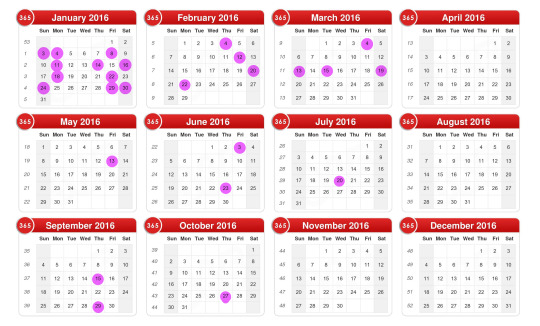
Chapter-wise, the first third of this story (Chapters 1 through 12) was written and posted in 2 months, and TWO THIRDS of the entire story (Chapters 1 through 25 (rounding up)) were written in the first YEAR.
Wordcount-wise, HALF the story (roughly 100k words) was written in one year.
There was a dramatic drop in productivity at the middle/end of 2016 due to Real World Stress, mostly me graduating & getting a job, the presidential elections, and learning a family member was starting to have kidney failure.
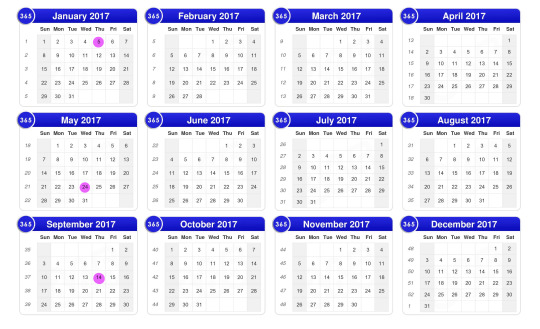
God, 2017 was a bad year for me, productivity-wise. In early June I lost said family member due to their kidney failure, and was completely unmotivated to work on You Monster for the rest of the year. I remember forcing myself to write for NaNoWriMo that year, and it helped snap me out of my funk, but I didn’t like how the writing came out and kept pushing off revising and editing the drafts for several weeks. I also remember getting really sick on christmas eve/day with a terrible flu, which made me unable to post the next chapter until January.
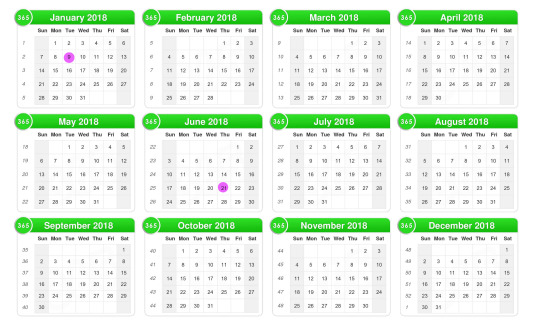
I actually felt a lot better mentally and emotionally in 2018. I WOULD have written more in early 2018, but that was also when the Hiveswap Comic Contest started, and lasted for 3 straight months with me doing nothing more than drawing comics for 12 consecutive weeks. Then, after that was over, I started thinking/planning more seriously about writing ANOTHER story, which later became Ghost Switch, and I offically started that halfway through 2018. I originally thought about making Ghost Switch a written work, but it was basically going to be another re-telling of Undertale, which was what I was doing with You Monster anyway, and I didn’t want to write all of that out again, so I decided to make it a comic instead. It was a great decision for me art-wise, because now I’m improving my art skills through weekly comic pages, but it was also a terrible decision art-wise because now I GOTTA KEEP DRAWING POSES AND BACKGROUNDS AND DRAWING PEOPLE IS HARD.
Back to the point- I forced myself to write this fic again for NaNoWriMo that year, and was terribly upset that I still didn’t finish. But this time, I forced myself to revise and edit my writing until it became something I could tolerate, and posted the next chapter in January (again, but this time because my writing needed far more revisions than last year’s nano draft)
Getting back into revising and editing DID seriously help me get back in the groove of Wanting To Write, but it was a little trickier now that I was also drawing a comic, and it was hard to manage my time between the two, because when I write, I do it for great stretches at a time. I mean, like, 4 or 5 hours straight of writing. Same goes for comic making, too. sketching the pages can take me two hours, and cleaning/inking/coloring them can take me anywhere from 4 to 6 hours.
Hm. If I included the other fics I wrote during this time, I get the feeling these calendars would look a lot more active and colorful. Maybe i’ll do that for myself later, so I can see how much I posted in 3 years.
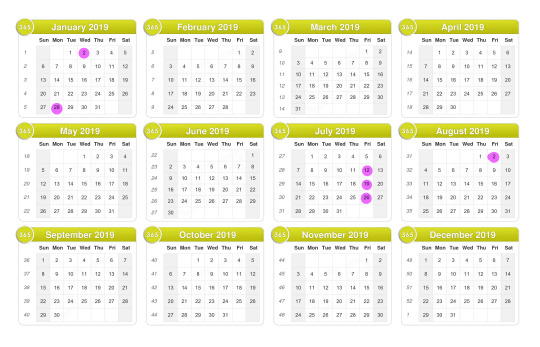
This year, I was absolutely determined to finish this story, even if it killed me. I was still struggling to manage my time between writing and art, mostly dedicating a few weeks to make a buffer of comic pages so I could have a couple of weeks dedicated to writing. It was time consuming, and I felt bad when I worked on one but not the other, but I finally got my breakthrough in May, when I had to take multiple trips to an automotive shop for several different car repairs. Instead of just leaving my car there and going home, I brought my writing spirals with me and just wrote and wrote and didn’t stop writing while I waited in their loby. I finally finished the rough drafts of my story after being stuck for 4 hours in a Pepboys, and spent two more full days typing it out. Then, I rested for a week, and spent 3 more revising and editing the remaining bits. I was hoping to get the whole thing done and posted before July ended, but that did not end up being the case. For me, when we finally get to August, we have entered “the end of the year”. Ah, well. Even though I didn’t get the story completely posted before August, I can still take pride in knowing I finished it before the year was half way over~!
NOW FOR SOME NUMBERS!
I personally divide this story into 5 arcs, Ruins, Snowdin, Waterfall, Hotland, and New Home And Beyond (Which is basically anything that can happen after you unlock the true lab in-game)
Ruins
The Ruins arc I consider everything in chapters 1 thorugh 12. It is simultainiously the longest arc (chapter-wise, with 12 chapters which as mentioned earlier, is 1/3rd of the story) and also the shortest arc, only taking up 24k words (Which is an 8th of the entire story, or roughly 12.5%).It was also the quickest writen arc, as it was primarily prologue/first act material. Pretty much all of it was written in that first January. It’s 80 pages long, or 13% of all pages
Snowdin
The snowdin arc (chapters 13 to 22) is just under 25% of the entire story, coming in at 49 thousand words (on the nose!) It is the second longest arc in both word count and in number of Chapters (10, to be exact~) It took me roughly 4.5 months to write this arc. We also spend the most physical in-story time in Snowdin. Almost 3 full days, which is half of the story’s timeline (not counting the 7-8 years in the Ruins. That was all set-up) It’s 172 pages long, or 28% of all pages.
Waterfall
The Waterfall arc (Chapters 23 to 28) is the longest arc wordcount-wise, making up another 25% of the story, coming in at 53.6 thousand words, and dead center when it comes to the number of chapters it makes up (which is 6). Looking at this now, litterally half this story takes place in Snowdin and Waterfall. Roughly one full day is spent in waterfall, from noon of the first day, to roughly late morning of the second. This arc took me 11 months to write/post, and if you read the notes for these corrisponding chapters, you can tell I was not having a good time during it. It’s 178 pages long, or 29% of all pages.
Hotland
The Hotland arc, (chapters 29 to 32) Is the shortest arc chapter-wise, with only 4 (10% of all chapters), and second shortest arc wordcount-wise, coming in at 36 thousand words, or about 18% of the story. It’s also the shortest in-story arc time-wise, seeing as you only spend about half a day here. I did not like writing the hotland arc! Mostly in part because Hotland is my least favorite region in the game. Chapter 32 is probably my least favorite out of all of what I’ve written. It was difficult figuring out what to do with Alphys and Mettaton, seeing as their interactions with you in game heavily focus on you and your human-ness. I am quite glad that each chapter was pretty neatly divided by in-game floors. It was a good way to know where a chapter could end and when I could give the characters some breathing room. It took me over a year to complete the Hotland arc, and most of that time was because I didn’t want to revise and edit what I wrote. It’s 123 pages long, or 20% of all pages.
New Home and Beyond
I don’t consider the True Lab part of Hotland because of in-game story reasons. You can’t access it until you’ve gone to New Home at least once, and once you enter it, you cant leave until you finish it, which, again, takes you to new home. Honestly, once you get to the true lab, you’ve won the game. There is no way to ruin your pacifist playthrough once you get to the lab, and while the amalgamates may kill you, you can’t “lose” once you get this far. That’s why I consider Chapter 33 the start of the New Home arc even though in my story we haven’t seen new home yet (mostly because there are no saves or resets in this story, so we kinda couldn’t have gone there first).
The New Home arc is the second shortest chapter-wise, making up the last 5 chapters (13% of all of them), and is dead-center when it comes to word count, finishing with 46.5 thousand words, or roughly the last 25%. I was actually really excited to write everything from chapter 34 to 36 after having been fantisizing about it in my head for the last two years. I gotta be honest, the end of chapter 37 gave me some trouble. I was still making edits up to a few days before it went public, but I think I got the feelings I wanted across~ It’s 161 pages long, or 26% of all pages.
Extra???
I started keeping a word file for bits of dialogue and scenes that I originally wrote in my spiral, but ultimately cut for one reason or another. Mostly these are just sentences and snippets that sounded redundant, ooc, or were just an alternate dialouge I decided not to use. I didn’t start doing this until chapter 28, according to my files, but according to the masterfile, there were 6.4 thousand words I ended up not using.
There are, in fact, several bullet points I had originally planned and ended up not using, such as Sans ASKING Undyne to keep an eye on the kid while they were in waterfall, which sounded hypocritical after I wrote him coming to peace with them, as well as having Asgore tuoring the Underground that week, and thus Sans, Papyrus, Undyne and Alphys having to hide Frisk from him once they become friends. (the painkillers Alphys also gave frisk were actually supposed to induce drowsiness in Frisk, making them fall asleep so Alphys could keep them from going to New Home, but this was a point I dropped at the absolute last minute, and you can tell if you re-read chapter 29, because it’s hinted at, but the painkillers are never mentioned again. I figured that plot point was a little too dark for Alphys’ character)
Fun Fact: the zalgo text in Chapter 27 DOES actually have dialouge in it, if you know what to look for. Only one person has asked about it, but no one has yet to decifer it.
AT A GLANCE:
ARC LENGTHS (CHAPTER WISE) SHORTEST TO LONGEST
Hotland (4 Chapters)
New Home and Beyond (5 Chapters)
Waterfall (6 Chapters)
Snowdin (10 Chapters)
Ruins (12 Chapters)
ARC LENGTHS (WORDCOUNT WISE) SHORTEST TO LONGEST
Ruins (24k)
Hotland (36k)
New Home and Beyond (46.5k)
Snowdin (48k)
Waterfall (53.6k)
ARC LENGTHS (PAGE COUNT) SHORTEST TO LONGEST
(Same order as above)
TIME TAKEN TO WRITE/PUBLISH, SHORTEST TO LONGEST
Ruins (1 month)
Snowdin (4.5 months)
New Home and Beyond (~6 months)
Waterfall (11 months)
Hotland (>1 Year)
Other Numbers For Some Reason
Chapters 1 through 19 make up the 1st 50k words (this when Frisk falls into the underground, up to Sans attacking them in the kitchen) 19 chapters
Chapters 20 through 26 make up the 2nd 50k words (when Frisk decides to seek asgore’s help, to when Undyne cuts the bridge) 7 chapters
Chapters 27 through 31 make up the 3rd 50k words (when Frisk dislocates their shoulder to Flowey killing the messenger spider) 5 chapters
Chapters 32 through 37 make up the 4th 50k words (When Mettaton decides to change the programming, to Frisk’s final choice) 6 chapters
Only 5 chapters exceed 10k words, they are chapters 22, 27, 28, 33 and 36
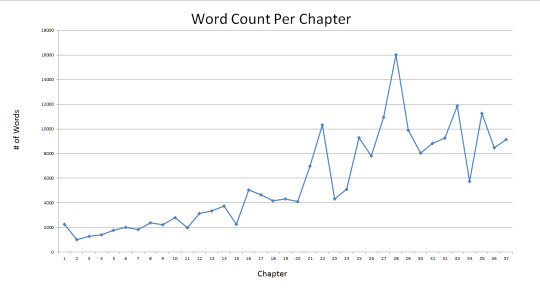
Here’s a visual representation of all the chapters and their word counts in relation to one another. I was so startled by the spikes of chapter 22 and 28 that I had to go back and skim the chapters to remind myself what went down in them and why they were so long. Chapter 22 is papyrus trying to keep the human in snowdin while sans runs some errands, and then the human discovering the skelebro’s deceit. Chapter 28 is the human realizing Undyne tried to murder them, and then escaping from waterfall. I distinctly remembering saying I could have split chapter 28, but I was so tired of writing waterfall that I refused to do so because I just wanted it to end already.
I find it absolutely hilarious how consistant my word count was until chapter 20 (chapter 15 is an outliar), and then everything went off the rails.

Here’s a graph of the total word count, shown to you NaNoWriMo style~ (I spent way too long in excel making both of these charts, please validate me)
The climb definitely looks a lot less drastic here, as it is always building on itself, but if you look closely, you can see one or two inflection points, roughly around chapter 20 and 28.
FINAL THOUGHTS
I’m so glad to finally be done with this story. It’s certainly deviated from what I originally planned, but I think all the changes are for the better. Now I can think about writing other things, like the PTA!AU shorts I’ve been meaning to do. It was fun and it was challenging, and this is literally the longest thing I’ve ever written in my life. Will I ever make a story this long again? Maybe?? If I ever encounter another game with as much character and worldbuilding as Undertale that also just hits me in the feels the same way, I might, but for now I’m going to focus on other projects (most of them still undertale related, but shut up)
Got any questions, comments, concerns for my fic? I’m so glad it’s done, now, and I’d be happy to talk about my thoughts behind it~
#Undertale#Fan Fic#My Writing#Long Post#you monster#I still dont have internet so I'm gonna push this up in the queue
12 notes
·
View notes
Text
Updates for Book 2 & 3 from Twitter
Now that I’m free, I’ve complied a list of tweets that give more info about Book 2 & 3 but I’m still lazy so i just copied and pasted them:
- “Plot twist, in this story, Time actually *is* a place”
- “Half of Mooncallers is based on my nightmares ~”
- “The second book is far more complex and full of substance. A ton of questions that were left hanging in the first book are finally answered in this one!”
- “This second book is veeerrrry mind-stealing. 🦋 Literally. You'll see what I mean once you read it”
- “Book three is already fully outlined, so maybe that one will come pretty quickly too! 😍” (Nov 23)
- “Okay, Mooncallers: Shadows Burn is unsettling as hell, even to me, but I'm writing the third book now, and this one is just as bad if not worse. I can't wait to give you all the creeps. 😈”
- “Currently sketching out the cover concept for book three! Ohhhh exciting exciting AND SUCH GREAT COLORS 💛🌹🔥”
- “Ravens become a pretty big part of the story later too”
- “446 in total, but the story itself is 410! 😊🦋” (pages in book)
- “No, I completely agree. Sometimes I order eBooks simply because I'm impatient, but having a physical copy in my hands makes ALL the difference.” (inserted this since it shows that Leda has been possibly reading more)
- “I wholly disagree. The world I write about has become so real to me that now my NLP responses have switched to the realistic frame when it comes to talking about my work. In my eyes, to write is to become a part of it so wholly that you are no longer here.” (about her writing process)
- “Oh boy. 🦋💏����” (describing book 2 in emojis)
- “Book 3 is 75,000 words now, 20/35 chapters in the first write are finished, so that hopefully won't be much of a wait either! 😘💕” (Dec 10)
- “Indeed! It is a cross between dark fantasy and spiritual fantasy. But all of the divines involved are original. There is also a significant lot of horror and mystery involved! 🦋”
- “I dooo plan on doing this, at some point, so keep an eye out! 😜🦋💕” (in replying about getting a book personally signed)
- “YES THERE WILL BE A PAPERBACK FOR BOOK TWOOO! Comes out the same day as the eBook and hardcover! AND I will be revising book one and putting it out for hardcover in the next couple of months!! 😍💕”
Amb
3 notes
·
View notes
Text
25 Questions Tag
Thank you @rosecorcoranwrites for tagging me! :)
1. Is there a story you’re holding off on writing for some reason? I’ve been holding of a murder mystery novel I was planning about year? two? ago. At some point I realized I’m not ready for it, not because it would need better writing than fantasy, but more like I felt I didn’t understand our own world good enough yet (does that make sense?) and didn’t yet had the means and patience to do enough research to get the understanding.
2. What work of yours, if any, are you embarrassed about existing? Oh boy... Many. The bright side is, I’m so bad at finishing anything I start that I have never finished a full length novel. (Though I’ve written many and many terrible things that only counts as short stories because of length.) I remember writing starting a fantasy story in high school or primary school where main character was a prince of tyrannical kingdom and suddenly he changed to a black panther (not the superhero) and couldn’t change back. Of course he came across the shape shifting rebels and there was of course this girl that turned into a tiger and of course they didn’t get along but we all know how that ended up. I’m pretty sad that it was so many computers ago it is lost forever.
3. What order do you write in? Front of book to back? Chronological? Favorite scenes first? Something else? Chronologically. As character exercises I tend to write my favorite scenes as I invent them, but usually they don’t end up in the novel or at least without some changing.
4. Favorite character you’ve written? Would you pick a favorite of your own children??
5. Character you were most surprised to end up writing? I’ll go with Valeri. He is not the usual type to end up my main character and that is the precise reason I made him. I don’t want to limit myself with writing only characters I would like in real life. I definitely wouldn’t like him if I met him, but I like him as a character. 6. Something you would go back and change in your writing that it’s too late/complicated to change now? There are no such changes for me. I have started my current wip three times from the scratch. If I feel there is such a big change that should be made I drop the project for a while and think about it. If I still want to write it, I make the change, if I have fell out of love, I move on. (Also as I’ve never get so far as the finish, it is possible.)
7. When asked, are you embarrassed or enthusiastic to tell people that you write? Embarrassed... Usually I’m not shy and I’m pretty confident in myself, not caring really what other think, except when it comes to writing. I’m not really sure what is it, but I think it’s that I’m pretty private person and writing is something I do right from the hearth.
8. Favorite genre to write I like historical fiction so much too (also mystery), but I have to say fantasy. I just love the world building!! At same extend you can’t do that much world building in any other genre (except scifi), and I love it.
9. What, if anything, do you do for inspiration? Read books and read especially non-fiction. Most of the time reality is stranger than fiction. 10. Write in silence or with background music? Alone or with others? Definitely alone and mostly in silence. Though sometimes instrumental music (ambient, classical or movie music)
11. What aspect of your writing do you think has most improved since you started writing? I don’t know, I had so many flaws (still do) that I can’t really say what I was worst at.
12. Your weaknesses as an author? Firstly: finishing the god damn thing. Secondly: action scenes and writing action overall 13. Your strengths as an author? Characters and world 14. Do you make playlists for your work? Sometimes but rarely use them as I prefer silence :D 15. Why did you start writing? I had so many things in my head I wanted to put on paper. It’s my form of self-expression. 16. Are there any characters who haunt you? Currently Valeri. I can’t get him of my mind :D
17. If you could give your fledgling author self any advice, what would it be?
Do and outline, decide ending before starting. Outlining isn’t for everyone but it is sure worth trying. And you start with FIRST draft, it is something like a sketch, so just write it, don’t think too much. Then you can write second, and third and as many drafts as you need.
18. Were there any works you read that affected you so much that it influenced your writing style? What were they? I would argue that everything that I’ve read have affected my writing style, some more than others. Nothing very clear, I think. Of course Harry Potter, almost anyone my age can say that, but I’ve read so little lately that I really don’t remember how each author writes. 19. When it comes to more complicated narratives, how do you keep track of outlines, characters, development, timeline, ect.? With Drive. I have docs where I write all the names of the characters, no matter how unimportant they were, and tell in few words who they are. I organize the docs by area. Then I have a docs named ‘timeline’. There I have all the historical events as well as main events of the story listed by year and month. Also I have list of character arcs and subplots for every main character. And then of course I have list of chapters and events in each, also some notes on the chapter. As you can see I like listing things. I fill all the lists as I go along. 20. Do you write in long sit-down sessions or in little spurts? I either don’t write at all or I sit down straight seven hours and write non-stop. I don’t have in between mood
21. What do you think when you read over your older work Depends how old :D If its a few years old, it’s surprisingly good. If its about five years old it’s in the awkward zone where it is bad, but not bad enough to be funny, reading them makes hurt inside. Everything older than that is just super funny. 22. Are there subjects that make you uncomfortable to write? Not really. I’m not planning on (at least yet) showing my writing for anyone but here in internet where no one knows me and for my boyfriend who know me inside out and I have nothing to lose :D so I feel I can write literally anything. Only thing I can think of is sex scenes. I really like smut but I’m pretty bad at it, as I don’t want it to feel erotica but also I don’t want it to be censored or too vague. 23. Any obscure life experiences that you feel have helped your writing? Hard to name anything specific as I believe that all life experience helps writing. You know, when you write about people and life, I really helps to be people and live. 24. Have you ever become an expert on something you previously knew nothing about, in order to better a scene or a story? While starting to write Saga of a Shieldmaiden, I became kind of a expert on Finnish mythology and life and history of Vikings. My knowledge was very limited on both subjects before that. Also for a murder mystery novel (that I mentioned in the first question) I read a criminology book.
25. Copy/paste a few sentences or a short paragraph that you’re particularly proud of. I answered same question before in another tag game, and I’m now too lazy to translate another paragraph. So this one is from the original Saga of a Shieldmaiden (that I’m now revising). It might be a bit too long though.
Something big was moving around me as I felt the water flowing differently. In the thickening darkness I couldn’t see anything. Or maybe I had my eyes closed, I couldn’t be sure.
It is not the sea that is suffocating you. It is the fear. You reek of it. You are so full of fear, it is dripping out of your throat. So full, your breath cannot flow.
I felt a touch on my throat. It was not a touch of a human. It was not a hand of a human. Massive crooked claw rested on my neck. The claw was rough and stony hard, full of scales. Sharp end of the nail pressed against the skin of my throat without piercing it. I felt a breath of a warm current behind my back. One breath caused so strong tide, it would have wiped me away, if the claw wouldn’t have kept me put.
Let the water into your lungs. Let the salt clean you of fear.
Every moment without air led me deeper into the dark, closer to death. Maybe he was the Death. I turned to look over my shoulder. To my horror I was faced by great, scaled, sharp-fanged head. A head of a dragon. It’s long serpentine body seemed to extend twisting into the endless blackness. The silvery scales glowed in the darkness of the sea and the deep-blue wells that were his eyes looked at me without blinking.
I’ll tag @lady-redshield-writes, @coda-wolf, @alittle-writer, @starlitesymphony and @plaguecraft! :)
6 notes
·
View notes
Photo
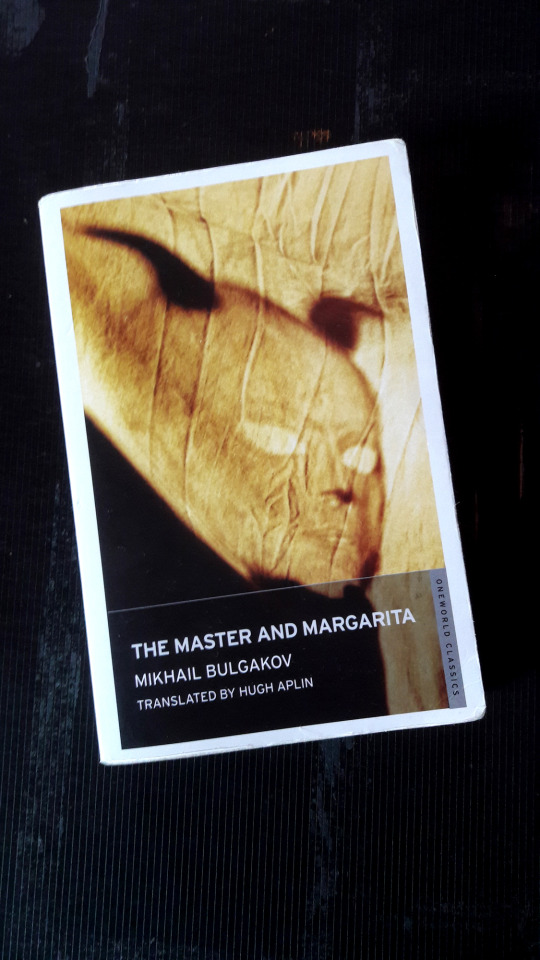
With the coronavirus forcing me to stay home maybe it’s finally time to review that pile of 7 read books by my bedside, starting with review part 1 of The Master and Margarita, which I actually wrote in January…
Part 1 – Structured Chaos or Unorganized Strategy
Warning: Mannnnny spoilers.
The Master and Margarita by Russian author Mikhail Bulgakov. Where to start? Most blurbs describe the story as the following: the Devil and his companions descend upon Moscow and create havoc amongst society. Only the “Master”; a failed writer committed to an insane asylum, and Margarita; his faithful lover, can escape the Devil’s plans.
Starting with story structure: the character of the Master, supposedly the lead protagonist, is only introduced in chapter 13, the novel actually opens with a poet (whom at first I presumed was the main protagonist), meeting an editor of a literary journal, at a park to discuss work. The Devil, disguised as a German professor, rocks up and interrupts their discussion. Chapter 2 starts a whole new story, it’s the story of Pontius Pilate, the Roman governor who condemned Jesus to death. Bewilderingly we are immersed into yet another world and we literally get a novel within a novel.
The Master and Margarita is divided into two parts; the first alternates between multiple comedic sketches illustrating the havoc committed by the Devil and his gang, the sufferings of the poet, introductions of armfuls of new secondary characters, the eventual introduction of the Master, and introduction of Margarita, and the story of Pontius Pilate.
Each comedic scene is almost like its own short story. A few years back I read a collection of Russian short stories and I instantly recognized in The Master and Margarita a number of the same styles, particularly the fondness for taking an absurd event and playing it out seriously in an everyday scenario. For example in one scene a bank manager is transformed into nothing but a suit, you can’t see his head or hands but the suit continues its work as if nothing out of the ordinary has happened, whilst outside sits his secretary (possibly also his secret lover) crying and at a total loss as what to do to bring back her boss.
These comedic scenes were so rich in detail, and so episodic by nature, that I found it hard to make quick progress through the book. After each chapter I felt I needed a pause to let the last scene sink in. Consequently, it took me ages to get through The Master and Margarita. I’ve often come across books claiming to use a mixture of styles, but The Master and Margarita is the first one I’ve thought “holy hell, this is it”. The second half of the novel takes a more linear approach to the story, chapters 19 to 24 are dedicated to Margarita, it’s the first-time sequential chapters follow the same plot instead of alternating between storylines.
This incoherence isn’t surprising when we consider that Bulgakov wrote the novel over a period of 12 years, and constantly made revisions. This is a novel that exists in six variations. Some of the changes in style are artistic and interesting, others are just the product of an ever-changing mind.
Review by Book Hamster
#just finished reading#the master and margarita#mikhail#mikhail bulgakov#bulgakov#russian#russian literature#odd novels#love reading#love books#The Devil#devil#demons#witches#book blog#book covers#strange books#strange things#comedic books#Black Comedy#sense of humor#literary structure#cult classics#book hamster#lunitic#censorship#russian censorship#Religion#religion in books#pontius pilate
1 note
·
View note
Text
1. more cereal than milk 2. no 3. a broken adventure time card holder given to me from the one that got away on halloween three years ago 4. i don’t drink coffee & i take my tea with two sugars, sometimes one and a half, depending on the size of the mug 5. yes 6. no, but i’d like to 7. - 8. words 9. no 10. side 11. shipping each other with males whom they have a vague connection with (e.g. makes a teacher laugh once, sees a random boy’s name on their Snapchat contact list that we don’t know,) 12. earth 13. my brother showing me a meme 14. spiral stairs, raw brick walls, a neutral colour scheme and warm fairy lights. lots of them. these fairy lights will be stringed across the walls and have candid poleroid photos pegged to them. tables covered in newspaper clippings, sketches of plants and fairytale creatures, cutouts from magazines and used mugs. strange abstract paintings from market stalls that we thought were funny, creaky wooden flooring and shaggy rugs on top. 15. 99% of our solar system’s mass is the sun! the sun is fucking huge 16. spaghetti without the sauce 17. blonde, but people think it wouldn’t suit me. blue seems intriguing 18. i used to write these cheesy erotic short stories about my friend and some guy (see no. 11) on scrap pieces of paper for my friends to annoy the said friend. these papers are now lost, but the memories of them aren’t 19. no. i have tried, but i always forget about it after a while 20. blue, for the first girl my heart latched on to. 21. i don’t have a specific bag, but an assortment of school bags that constantly broke or were horribly bulky that i kept pushing or bashing people 22. is anyone? 23. write, but i never get the time anymore 24. yes 25. me break into someplace? ha i’m a pussy 26. what is this question? my school shoes, because i’m obliged to wear black shoes? 27. bubblegum is already a flavour 28. sunset 29. one of my friends literally lights up from about 20 to 100 if you mention something she likes. she has such pure, childlike enthusiasm 30. yes 31. socks. I despise the rise of ankle socks. you’re paying the full price for half a sock. like?!!1!? otherwise, i enjoy all socks, frilly, knee length, comical, odd. maybe not sports socks though 32. i have never been out with my friends after 3am. sad times. 33. apple pie, no doubt 34. i had a stuffed tiger toy called “Tiger” but pronounced like “Tigger”. he wasn’t the Disney one. my father bought it for my mother, and she gave it to me. my younger self called him my husband and I liked kissing him. he currently sits at the back of my wardrobe. 35. i am the stationary whore. i steal and hoard pens, pencils, rubbers, coloured paper, paper clips, etc, that i find on the floor or abandoned in classrooms when the coast is clear. 36. coldplay 37. messy 38. the sound of chewing, saliva, and those sort of things 39. i’m not sure. if i had to choose, i’d guess grey? 40. i have a gold ring with a gold bow on it in the drawer of my wardrobe. back in high school, me and my mates had this inside joke that one of my friends and I were “married”, so one April she and the others came to my house and she joke proposed to me. 41. Thanks for the Trouble, by Tommy Wallach 42. i wish i had a small, pretty corner coffee shop to tell stories about, but i just don’t drink coffee. all i got is the Starbucks and the Costa’s i grab hot chocolates from when i’m outside and alone, or when my friends feel like it 43. probably my cat 44. AS results day. we all got crappy grades, and the four of us sat in a playground and laughed 45. no 46. compasses and protractors are banned from my school because they’re considered weapons of math destruction 47. peppercorns 48. i don’t think i had a fear when i was younger, but now i fear rejection and being seen as boring 49. i’ve never owned a record and the last CD i had was given to me during primary school. everyone uses online copies now, unless they’re being aesthetic ™ 50. stationary (see no. 35). 51. Jenny, by Studio Killers 52. is Hollyweed considered a meme? 53. nope. i’m uncultured swine 54. my mother 55. pretend to forget, like faking momentary amnesia, and boy, it was the worst decision i’ve made to this day 56. nicknames, gift giving outside of holidays or birthdays, remembering little details 57. chaotic, suicidal, but nearing the end, strangely peaceful 58. i’m the vodka aunt, for i spike my own tea with it, as an “experiment”. I’m yet to find the wine mom 59. religion 60. yeah, i like it. La Belle Dame Sans Merci, by John Keats, at the moment, but i haven’t read enough to make an informed decision 61. a toy cross bow for my father. he never used it, and i don’t know why i got that; i just wanted to get him something. for me, a penguin cuddly you from a girl i hardly talked to anymore. i was sixteen or seventeen i think? i don’t mean to be rude but why? 62. i don’t have time to drink in the morning. the exception would be when i was doing that vodka-tea experiment (see no. 58) 63. my books are currently in a rainbow colour order. if they weren’t, i wouldn’t care too much 64. a pale blue, with a smudge of purple-grey clouds 65. the first friend i ever made, Tusma. she moved houses at the end of year three. i haven’t seen her in about eight years 66. depends. i’m torn between going dainty and picking yellow: buttercups, dandelions, daisies, with soft clovers and the occasional purple wildflower, like a rugged, forest fairy. or standing fierce, a red rose crown, thick with thorns, holly leaves and berries, some crushed, scarlet liquid dripping down my forehead but eyes staring straight ahead. 67. powerful, invisible, stealthy 68. cold, bitter, sometimes dry like a cough or wet and uncomfortable. it doesn’t snow anymore 69. scrabble, monopoly 70. in year nine, some kids decided they wanted to use a ouija board. i was curious, and i walked into the science room they were planning to use when the teachers were gone and the lights were off, despite my friends’ protests. it wasn’t an actual ouija board, but an imitation, scribbles on a piece of paper. i can’t remember who did it with me, but i’m pretty sure some of them were the popular kids. we felt no presence, although everyone tried their best to scare each other. we never said goodbye. no ghosts have haunted or killed me yet. 71. earl grey, or normal tea with a sprinkle of ginger 72. i feel as if i’m going to forget and can’t handle things, but i rarely note things down. i seem to cope, just 73. daydreaming, procrastinating, not being able to keep my own secrets 74. shy, quiet bean, needs to be protected at all costs, their laugh is more of a giggle, good at art, baby of the group, secretly wants to get drunk and make out with people, i suspect a little bi-curious but i can’t be sure, has technology and food kinks (but not at the same time) 75. i have a black and white cat named Wallace, after Wallace from Wallace & Gromit, because he eats cheese. he has a wonky tongue because he cut it on something but we never found out what that something was. he’s eleven years old, so he’s getting on now, and i think there’s a rising rivalry between Wallace and a mysterious black cat that keeps popping up near our garden 76. revising, duh 77. have never tried pink lemonade, so yellow 78. hateclub 79. sent me a claraxeleven edit as means to make me stay when i was thinking of running away. i thought only those deep in the doctor who fandom watched those, and it may have suggested i was rubbing off on him 80. lilac. i chose it because when i first moved into this room i was sharing it with my younger sister, so i wanted to choose a colour that she wouldn’t hate that was also not pink 81. watery brown stone (cba) 82. yeah, i was usually in the top or second top groups 83. i don’t buy albums, so i wouldn’t know where to start 84. yes. a small TARDIS at the back of my neck. maybe a ruffled feather, despite it being a little cliché, it has a literal importance to me. something related to space on one of my thighs, and perhaps something with roses, or skulls 85. unfortunately, no 86. i don’t know what those are 87. The Imitation Game, High School Musical, Edward Scissorhands, Men in Black, Shrek, Home Alone, Independence Day, The Wizard of Oz, Harry Potter, Hidden Figures, the Star Wars trilogy, Freaky Friday, Titanic, Jurassic Park, Alien, Terminator, Jaws, Jumanji 88. dancing when i’m alone, and dabbing (sorry not sorry) 89. debatable 90. it isn’t a city, but my favourite place is the Isle of Wight. i first tried tea in a big blue breakfast room at the b&b and learned to play pool at a pool table you had to put a pound in to play. i fed a lamb and my brother wet the bed and we watched a Lara Croft movie in our little room and it rained most of the time but i loved it all so 91. no where 92. barely sprinkles 93. bedhead, sometimes brushed 94. yesterday, a boy who loves me but i ran out of love months ago 95. nothing unusual 96. procrastinate 97. myer briggs? what is this? capricorn, gryffindor 98. NCS, where we all hiked across the coast of Wales, and at the end of it i thought my legs were going to fall off and my feet were all numb. beautiful views though 99. If I Lose Myself, One Republic; Give Your Heart a Break, Demi Lovato; Get Out, Casey Abrams; Oh No!, Marina and the Diamonds; Spectrum, Zedd 100. past, because i know what i’d do
3 notes
·
View notes
Text


Fuzzyface/Gleep/Grover
DEBUT 1967
PERFORMER Frank Oz
Fuzzyface is a name that has been unofficially given to an early version of Grover by fans. The name derives from a comment made by Kermit the Frog in a first season sketch of Sesame Street. The term "fuzzy face" was actually just a smug remark made by Kermit about the then-unnamed monster because he literally had a fuzzy face. In the same sketch, Kermit calls him "the hairy one" in a similar fashion (the monster also calls himself the hairy one). In another sketch, in which Kermit has Grover bring over nine blocks, Kermit similarly refers to the monster by a number of different terms, including "the hairy monster", "the furry one", and "the fuzzy one".
The term "fuzzy face" was also used by Herry Monster in reference to Cookie Monster during the second season version of Up and Down and by Floyd Pepper towards Animal in episode 222 of The Muppet Show.
The season one pre-cursor to Grover (previously seen on The Ed Sullivan Show as a monster named "Gleep") was performed by Frank Oz, just as the established Grover would be, but his appearance and mannerisms were somewhat different. His design consisted of a greenish-gray fur, and a slightly gruffer looking face. Oz also used a raspier voice for the character, and played him a bit more unkempt than Grover would later behave, certainly without any of the sweetness or consideration for others. Still, even in the first season, some characteristics of Grover could be seen, such as getting simple things wrong, being stomped on or exhausted, and slapping Kermit on the back. A number of sketches with this early "proto"-Grover were later remade with the more familiar blue Grover, including the "first and last" sketch, a sketch where Kermit has Grover count blocks, and the well-known "Near and Far" sketch.
Due to the differences between the season one Grover and the later Grover, who premiered in season two, fans applied the name "Fuzzyface" to his season one appearances based on the "fuzzy face" comment - creating an unofficial new persona designation for the character. However, Sesame Workshop considers this green character to have been Grover, despite not gaining the name until season two. In its 35th anniversary board game, one trivia question reveals that Grover was originally green, suggesting that these characters are the same, albeit models of the evolution of the character. Additionally, sesamestreet.org has "Old Grover" as a tag in the "First and Last" sketch from the first season (although the character has an orange nose in that sketch).
In 2013, the original Grover puppet from 1967 was donated to the Smithsonian Institute. During restoration of the puppet, Bonnie Erickson, executive director of The Jim Henson Legacy, referred to the puppet as "old Grover."
This original "proto"-Grover puppet appeared with the revised Grover puppet at the end of the "What Kind of Fool Am I?" sketch on The Ed Sullivan Show in 1970 and was used in a Season 2 sketch, given a wig and a dress, to become Grover's Mommy.
39 notes
·
View notes
Photo

25.02.’17
family trips, kimonos and kitten children who love their dads
yuri!!! on ice, yuuri pov, (implied) victuri, (maybe vaguely hinted at) otayuri
victor orders some custom made kimono, victuri are basically yuri’s dads and yuri is so their child and doesn’t even bother denying it if asked, there’s a two-week vacation in hasetsu where even otabek is invited, a festival and lots of family fluff.
(i literally wrote the last last part of this chapter while listening to the duet on repeat. as one does.)
part 2 (part 1 here), (ao3)
~
the next day, yuri is loud and excited.
he goes through the photos from the previous day with yuuko's triplets, an enormous smile on his face, and showing off the goldfish he caught. yuuri wonders what his face will do when he sees today's outfit. he has to bite his lip to keep from laughing.
the day passes by pretty fast, between boisterous children (and “children”) who want to post every little thing to social media, some skating (because it’s them and they can’t help themselves) at the ice castle where yuuri and victor manage to rope yuri and otabek into trying some lifts and spins with them, and a nice, long, relaxing soak in the onsen.
before any of them know it, it’s almost evening, and yuuri can honestly say that he’d be okay with it if they were to decide not to go to the festival, because the day has been wonderful enough so far.
but then victor comes back from where he’d went to his room, this time still dressed comfortably in his usual green jinbei (because it’s too early yet) and carrying four packages.
yuuri sits up straighter. even axel, lutz and loop quiet down, curious, but with their cameras at the ready. yuri looks like he’s trying really hard not to show his curiosity.
victor puts all four on the table, spreading them out carefully, like they’re precious cargo (and they are), before picking one up and setting it down in front of yuuri.
yuuri pulls it close but doesn't open it yet. he knows what's inside, has a decent idea of what it looks like, though not an exact one, and he'd rather first pay attention to the others. victor seems to understand, because he doesn't urge him to open it, just picks up two of the remaining three and drops them in yuri and otabek's laps.
yuuri hopes the triplets caught their startled faces properly.
'n-now what? what's this? wha-' yuri stutters, clearly not having expected anything more after yesterday. his fingers fumble over the ties, hurrying to unwrap, disbelief and wonder and eager anticipation clear in his every movement.
the reds and blacks of the kimono and the dark green of the obi look refined, gorgeous, and yuri's lower lips trembles before he bites down on it.
'do you like it?' yuuri asks, and yuri nods almost numbly, unable to say a word. he can’t stop looking at it, he can’t stop touching it.
they turn to otabek then, who has kept quiet so far, his earlier surprise replaced by a soft, fond look directed at yuri. his hand on the younger boy's shoulder is gentle, but tethering like an anchor.
he's not quite as shocked as yuri, but he is surprised, the bashful smile on his face, the mindful way he handles the material, and the soft, grateful 'thank you.' as he looks it over speaking volumes of how much he had not expected to be included in this, and how touched he is by the gesture.
before any of them know what's happening, yuri pushes his bundle into otabek's arms with a ‘beka, hold my kimono’ and stands up, stomping his way to the side of the low table where yuuri and victor are sitting together.
‘yurio?’ yuuri barely has time to say, only just managing to catch a glimpse of teary eyes and red cheeks, before yuri swoops down and furiously hugs him and victor. both at the same time and hard enough to bruise.
it’s over in a matter of moments, and then he’s gone, back by otabek’s side.
the room is left in stunned silence. only loop’s camera shutter can be heard. if yuuri’s shoulder didn’t ache from the harsh embrace, he’d think he’d imagined the whole thing.
before anyone can say a word, yuri’s a flurry of movement again. he’s picked up his bundle from otabek’s arms and he’s dragging yuuri by the arm, shouting over his shoulder.
‘come on, katsudon, help me get dressed.’ and then, louder, ‘yuuko, i’m going to need your help with my hair when i’m done.’
yuuko smiles at him, though he can’t see it, and agrees. then she corrals her daughters, keeping them from sneaking after them. the internet does not need half naked photos of yuri plisetsky. yuuri, as always, is thankful for his friend’s amazing everything.
he almost falls over when yuri abruptly stops, steps back into the room and yells for otabek.
‘oi, otabek, you better come, too. victor’s probably shit at tying these things, you might as well have katsudon do it.’
yuuri can’t help laughing a bit at his fiancé’s affronted ‘hey!’ as he is once again dragged along.
~
the kimonos are even more exquisite than the sketches made them seem and a lot softer to the touch.
yuuri’s and victor’s have gold threads that give them a glimmering look in the flickering lights of the festival.
that aside, victor’s burgundy one is rather simple, lighter around his shoulders, becoming shades deeper, darker further down his body, becoming almost black near the bottom hem. the golden obi makes the simple yet elegant ensemble look regal, and yuuri can’t help thinking it’s only fitting.
yuuri’s own is dark indigo, the colorful, sequined design on the back of his costume carefully, if more elaborately stitched on the back. yuuri thinks he’s never worn something so precious (in every sense of the word) in his entire life. he makes a mental note to thank victor properly after they come back to the inn.
~
the second evening of festivities is no less fun than the first.
yuri challenges each of them to whatever games catch his eyes and interest, for once more carefree than yuuri has ever seen him, even after he’d one his grand prix finals’ gold. he doesn’t know more than a couple of words in japanese (not that anyone expects him to), so where he can’t get by on his english, he asks yuuri for help (actually asks, not demands passive-aggressively).
otabek is more relaxed than yuuri thought he’d be, clearly enjoying himself, and not getting overwhelmed. when yuuri asks, he tells him that it’s actually not the first such festival he attends, having visited japan a couple of times before.
they talk for a while, about their experience training in countries other than their own, as they walk behind victor and yuri who bicker in rapid-fire russian about something or other.
at one point, yuri decides he’s had enough of walking with the “gross lovebirds” and drags otabek away, going in the direction of a booth that yuuri remembers had a tiger almost as big as yuri as prize for some game.
‘it’s good that he finally has someone he’s willing to call a friend, don’t you think?’ victor asks from beside him, voice fond, eyes fonder, and yuuri leans his head against his shoulder, still looking towards the teenagers walking unhurriedly and talking happily.
‘yes.’ he agrees, because it is.
the blues and whites of otabek’s kimono paint a nice contrast to the reds and blacks of yuri’s, and yuuri privately thinks that they’d look like a couple if he didn’t know any better (wonders if victor made them to match on purpose).
he does know better, though, because yuri’s too focused on his career right now, and maybe a bit too young and too full of himself to think of such things, especially when he wants to take the world by storm, and besides, a first, real connection with someone doesn’t always end up in such relationships.
still, they look cute, they seem to understand each other, and they’re supportive of each other. if they have that, if they respect each other, no matter what their relationship’s like, then it’s okay. they’re still growing and they have all the time in the world.
~
by the end of evening, they’re all sitting together on a grassy hill, surrounded by people and waiting for the fireworks to start.
yuuri is leaning against victor’s chest, holding a cup of still warm tea in one hand and petting makkachin with the other, listening to his fiancé reminiscing about a festival he went to once, as a young teenager.
next to them, yuri is sitting with the stuffed tiger otabek won for him in his lap, hugging it to his chest like it’s the most precious thing he owns, talking excitedly with his friend. otabek, for his part, while he looks as subdued as he always does, also looks like he’s right where he wants to be, smiling gently at yuri’s exuberance.
the grin on yuri’s face is too adorable for a usually moody sixteen year old, yuuri can’t help thinking. it seems being able to unwind, to have fun and be around people he cares about (whether he admits to it or not), away from the pressure of skating and training and having to win, is good for him.
yuuri wonders if they could make this sort of holiday a regular thing. he’ll have to talk to victor about it sometime, though he’s sure he will agree. it’s the kind of thing victor would love.
when the fireworks finally start, yuuri looks around at his small group, each one enjoying the beautiful, colorful display, and feels like his heart is going to burst with warmth.
it feels so much like family, like a family he’s made for himself, and the happiness the thought brings him has him glowing inside.
he revises his earlier mental note. he has to properly thank victor later, not only for the wonderful kimonos, but for being him, for taking yuuri’s drunken ramblings to heart and deciding to become his coach, and for not letting yuuri go when yuuri was being anxious and self-doubting and stupid.
yuuri has never been so content, so happy in his life than in this moment, and he can’t help looking forward to whatever the future holds.
he buries himself deeper in victor’s embrace and fiddles with the ring on his finger, watching the fireworks light up the night sky. he smiles quietly to himself, one thought crossing his mind.
‘well now, there’s just one more thing that needs to be done.’
#yuri on ice#yuri!!! on ice#victuri#otayuri#katsuki yuuri#victor nikiforov#Yuri Plisetsky#otabek altin#by moi#fic#my fic#ellatriestowritedaily#yoific
15 notes
·
View notes
Note
what *is* your writing process?
First, it always starts with something half-formed. “What-ifs?,” blurry memory of dreams, people watching, drawing. And then you get to play scientist. If you buy into dichotomies of “science vs art,” then think of a writer being the best of both skill sets.For any skill though, the first step is always, always, always observation. So my process relies on being able to observe the outside world, my internal states, the interactions between these two, and how they shape or change one another. This all seems super abstract, but this is good practice for think about how fictional, non-existent characters might be formed. Second, become familiar with different forms of writing and what type of literary genre is best suited to tell the type of story you want to tell. Some stories aren’t multi-chapter worthy (if they aren’t and you try to force it, it’ll show. Trust me). There are three types of things to know about writing: mechanics of language, story structure, and being a writer.Third, sit that booty down and write. THIS IS THE HARDEST PART. Wanna know why? Because those first two things get put to the test AND you gotta write. You can read a lot of guides on writing but you really won’t know what you don’t know until you do something. You can work with something; you can’t work with nothing. If it stays in your head, it’ll always be this flurry of blurry ideas that never quite come to fruition. Characters on life support. Events in current stasis. A scene that runs through your head constantly like “Call Me Maybe.” But this “paint-by-numbers” method is kind of canned bullshit, the Easy Mac of advice about writing that isn’t really helpful. What all writers need is practical and useful advice that is: actionable, goal-oriented, and produces tangible, deliverables (aka something you can deliver and there is a trail for it). So, you can know the difference between an em dash and an en dash (there’s a difference, pinky swear), but it’s gonna do you shit good if you want to write. It’s super easy to tell people, “Just write!” You wanna know something? I’ve not worked on any ongoing stories I post for free on AO3 (another good rule? Promote the hell out of the stuff you work hard on. Ain’t no shame in having pride in your work). Why?Eh, I guess I could blame it on all sorts of things but, honestly, I’ve not taken the time to open the fucking documents on my many portable computing devices. You want to know “Ash’s Super Official Pragmatic Guide to Writing a Shit Ton Based on Her own Experiences that May NOT produce 100% Quality Results You Wanna Share with the World but Damn if it Won’t Make You Write a LOT.”? Okay, here it is:1. Only hand-write for quick notes, sketching out ideas, and the like. Don’t write by hand and then think you’re gonna transfer it over digitally all nice like. It wastes time, energy, and you’ll spend way too much fucking time agonizing over drafts as they exist on paper. That shit is for quick and dirty work.2. Open a word processor document OR a Google Doc. Honestly, I’ve moved to working almost exclusively on Google Docs because I can share with people more easily for editing. Word of caution: Docs won’t have some functionality like most word processing software but it isn’t the end of the world. Just see what you can live with.2a. Yes. You will get frustrated with learning how to type and use hotkeys and deal with stupid computer issues (like when things start tabbing over for no fucking reason). Don’t let this stop you. If you can understand what’s going on (i.e. it does not affect cogency/intelligibility), figure that shit out later when you’ve got time.3. While we’re on the subject, if you can only muster the energy to do ONE thing for a story, open a new document/start a new doc and NAME THE FUCKER. Once a thing is named, it exists. Congrats! You’ve now begun.4. You know all those tidbits you got floating around? Okay, pick one. You’re gonna bleed that thing dry. DO NOT: focus on character description. DO NOT have 90% dialogue. Not yet, at least. DO NOT focus on scene description. There is a start, there is an end. You know what they are. Make ‘em meet up.5. Eh, they can’t all be 80 Chapter epics. I’ve got a literal ton of digital documents that consist of three pages that are short and sweet--simply based on an idea that couldn’t go anywhere OR that I realized I had no interest in pursuing once I started writing. Once you get that thing finished, save it and then say, “Eh, that’s it for that.”6. Set yourself some goals. I don’t find it’s super helpful to chart my progress in days or hours but rather in pages. For all my AO3 shit, approx. 16 pages per chapter is what I’ve hit. Is it ideal? Nah. But it was my goal when I first started writing. So if I know I’ve got 16 pages to do something, I break it up by big landmarks. For a lot of chapters, I know where it begins and I know what the ending will be. I know things I want to happen (whether it works out is a writing process thing) so I work to put together the dots.7. Things you should always be asking yourself: is this boring me? Are my characters bored? If they were real people and I kept telling them to do these things, would they tell me to fuck off? Like, I don’t know about other people, but I’ve got one character (obvs, it’s Rook) who I’ve been writing and thinking about forever in different incarnations and she is SUPER bossy and opinionated and I FEEL bad, like physically/mentally, if I realize I’ve mistreated her (e.g. made her do something she wouldn’t do). If you’re bored, I’m bored. The end. There ARE times where you’re writing will be less compelling then other parts of your story, but boredom is something quite different. Downtime/quiet moments are not synonymous with tedious, drawn-out, “please shoot me already” writing. A lot of this depends, again, on observation. I know I kinda shit on the “Three Things” thing I made up and outlined at the beginning, but it doesn’t make them any less true. You need to be able to observe yourself. You’ve got habits. Some need to be changed if you wanna write a lot. What you need to write is different than what I need to write. I love using tools like pomodoro, pomodroido, and toggl. There are a lot of tumblr posts that have links to sites where it forces you to write 500 words before it lets you access your browser again (HA, joke is on it because I can just open up Firefox--obvs, site-blocking apps do shit for me because I eventually change browsers or just end up disabling the app) or you write one word at a time and so on. Heck, there’s a whole wiki dedicated to NaNoWriMo with TONS of resources concerning software and the like.BUT, this is all gonna mean shit without some motivation and accountability. Motivation is easy to unpack (you gotta want to do it, whatever your reasons. It might be good to unpack those but that’s a personal thing). Accountability? Well, that’s trickier. You can make yourself accountable (e.g. “I will write three pages a day, single-spaced, 12 pt font every day without revisions.”). But I find having external motivators better. I surround myself with people who write, I have a lovely and wonderful beta, and I also do things like this where I bluntly ask people to make me talk about (AND THINK ABOUT!) what I’m doing. If you’ve got more specific questions, hit me up!(also, @nonsensicaldiary, you asked this).
8 notes
·
View notes
Text
Nampō Roku, Book 6 (8.1, 8.2): Displaying a Natsume Together with the Chaire and Chawan.

8.1) On occasions when [the host] wishes to display a chaire, natsume, and chawan in a row on the jō-dan [上段]¹, [it should be done] as shown in the [following] sketch²: [the utensils should be] placed on two yang-kane, and the yin-kane that is found in between them³. This is known as tsuzuki-no-kane [ツヅキノカネ]; and because [this arrangement] is occasionally included on the shoin and daisu, it has been memorialized here.
That is not to say that [arranging the utensils in this way] is [particularly] good [to imitate]; but when there is no other option, one should understand [that this is a possibility], so it is said⁵.

[The writing reads (from right to left): natsume (ナツメ); chaire ・ dōgu ni yori, hidari-migi ika-yō ni mo (茶入・道具ニヨリ、左右イカヤウニモ)⁶; chawan (茶碗).]
The kaki-ire [書入]⁷:
〇 [Ri]kyū koji’s mitsu-gumi [三ツ組] should be differentiated from what is shown here⁸.

8.2) With respect to displaying a meibutsu (or something of that sort) as an hitotsu-mono, even though it is your own utensil, it is not appropriate to depreciate it [by placing it so that it overlaps the kane by one-third]: [the center of the utensil] should rub against the exact center of the kane¹⁰. With respect to this “suri,” it means that the center of the utensil should approach the exact center of the kane¹¹. Even though [this] will certainly be clear to the [naked] eye, this is, in fact, a secret ku-den [口傳]¹². Whether it approaches [the center of the kane] on the right, or on the left, is connected with the [other] circumstances¹³.
Ordinary utensils, however, are never said to rub against their kane in this way¹⁴. They all overlap their kane by one-third.
[Ri]kyū said, in the sōan, even though paying such close attention to the kane is not necessary, in the case of an hitotsu-mono (and other things of that sort), we should be accepting of the need to do so. Consequently, if [one gets into the habit of] being negligent when arranging ordinary utensils, it will be the same when placing an hitotsu-mono¹⁷. This is a case where training is indispensable¹⁸.
_________________________
◎ This entry was included in Kumakura Isao's Nampō Roku wo yomu [南方録を読む]. And while the illustration in the Sadō Ko-ten Zen-shu [茶道古典全集] shows the chawan and natsume both centered on their kane (which would make it impossible for the host to display a chaire in between them, no matter how small it was)*, the sketch in Kumakura sensei’s book depicts their orientation correctly -- with all three utensils overlapping their respective kane by one third.
While the Sadō Ko-ten Zen-shu and Nampō Roku wo yomu versions of the Nampō Roku have included all of this material in a single entry†, both Shibayama Fugen and Tanaka Senshō segregate the material that follows the kaki-ire into a separate section. This is why I have marked the two sections as parts 8.1 and 8.2. __________ *Given the number of errors in the Sadō Ko-ten Zen-shu version (where all of the sketches were redrawn for that edition), it is difficult to believe that the editors actually wanted their readers to truly understand this material. Indeed, the impression is that this is an example of feigned transparency (while trying to make things as confusing as possible).
†This seems to be in accordance with the way the material is distributed in the Enkaku-ji manuscript.
¹Jō-dan ni, chaire・natsume・chawan to, mi-iro narabi-kazari awase-taru toki [上段ニ、茶入・ナツメ・茶碗ト、三色ナラビカザリ合セタル時].
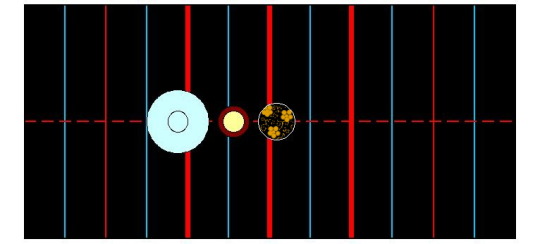
Narabi-kazari [並び飾] means to display (objects) in a row (narabi [並び] means to line things up, arrange them in a row). The meaning is seen in the above sketch, which depicts the present arrangement.
²Hidari no zu no gotoku [左ノ圖ノゴトク].
More literally, “in the sketch that is [found] on the left.”
In other words, the sketch that follows these comments.
³Yō no kane futatsu in wo hasamite oki-koto [陽ノカネ二ツ陰ヲハサミテ置コト].
Hasamaru [挾まる] means to be pinched between (two other things); to be caught in between.
⁴Kore wo tsuzuki no kane to te [コレヲツヅキノカネトテ].
Tsuzuki no kane [續きのカネ] means successive, or sequential, kane. In other words (as shown in the sketch) the chawan and natsume are placed on yang kane, with the chaire placed on the yin kane that is found in between those two yang kane.
For this to work, the chaire would have to be rather small (and probably rather tall, especially if there were four or five guests) -- such as the 1-sun 9-bu* old Seto katatsuki shown below†.

Such chaire were made at the Seto kilns during the second half of the fifteenth century, for orders placed by the members of the Korean expatriate community who wished to continue to practice chanoyu after arriving in Japan. __________ *1-sun 9-bu is the usual diameter of the classical ko-tsubo [小壺] chaire. Yet the height of these old Seto chaire permits them to contain enough tea for even four or five guests (ko-tsubo of this size rarely could be used to serve more than two people: this is why they were preferred in the early days, since only one bowl of tea -- offered to the Buddha -- was made, while their small size prevented waste, since the chaire was always supposed to be filled fully).
The same group of machi-shū chajin seems to have been the force behind the creation of the kan-saku karamono chaire [カンサク唐物茶入 = 韓作唐物茶入] -- which were made in Korea (as the name suggests) -- that imitate the classical ko-tsubo shapes, albeit in a larger size similar to the classical (2-sun 5-bu) “large” katatsuki chaire [肩衝茶入]. (Note that the Japanese nationalist “scholars,” working in the early 20th century, “revised” the interpretation of kan-saku karamono to mean “chaire made during the Han dynasty” of China -- nonsense, since fired pottery of this type did not appear anywhere in the world until many centuries later -- though hatred is almost always blind to inconsistencies in the preferred argument -- and, in fact, they are demonstrably made from Korean, rather than Chinese, clay, and were fired in a Korean nobori-gama typical of the fourteenth and fifteenth centuries, rather than the pit kilns used in China in those early days.)
In both instances, the intention was apparently to allow the chajin to employ arrangements originally devised for the other type of chaire -- using a katatsuki (albeit a much narrower one) for a ko-tsubo arrangement, and using a ko-tsubo shape (though of much larger dimensions) as a katatsuki. (Ko-tsubo and katatsuki were the two divisions of classical chaire -- as was emphasized in the writings that deal with chanoyu during Jōō's middle period and before.)
†These chaire generally lack applied decorative elements (such as a nadare that contrasts in color with the ground color of the piece). The first chaire to have displayed such an effect was the Hakata bunrin [博多文琳], that belonged to Kamiya Sōtan [神谷宗湛; 1551 ~ 1635]. Any purportedly old chaire that exhibits this kind of effect was likely made in the early Edo period, and perhaps associated thereafter with an old name (since such was the focus of chanoyu during that period -- and after).
⁵Kaku-no-gotoki naru ga yoki to iu-koto ni te ha nashi, yondokoro-naki toki kono kokoro-e-subeshi to iu-iu [如此ナルガヨキト云コトニテハナシ、無拠時此心得スベシト云〻].
Kaku-no-gotoki naru ga yoki to iu-koto ni te ha nashi [此の如き成るが良きと云うことにては無し]: kaku-no-gotoki naru [此の如き成る] means “to be like this;” yoki to iu-koto [良きと云うこと] means “good, so to speak;” nashi [無し] means “(this possibility) does not exist.”
In other words, though Rikyū is alleged to have arranged the daisu in this manner, that does not mean that we should emulate the arrangement as a matter of course.
Yondokoro-naki toki [拠無き時] means “on an occasion when it cannot be helped,” or “on an occasion when (the need to use this kind of arrangement) cannot be avoided.”
Kono kokoro-e subeshi [この心得すべし] means “(you) should know (that it is possible to do things in this way).”
⁶Chaire ・ dōgu ni yori, hidari-migi ika-yō ni mo [茶入 ・ 道具ニヨリ、左右イカヤウニモ].
“Chaire ・ depending on the [size of the several] utensils, it can [overlap the kane] to the left or to the right.”
In other words, if the chawan is especially small and/or the natsume is large, the chaire (which overlaps the yin-kane by one-third*) could project in either direction (at least in theory -- in practice, since there is only at most 4-sun 9-bu between the yang kane, it would be difficult to execute this arrangement unless all of the utensils were literally as small as possible).
As explained above (under footnote 4), the arrangement seems to require something like an old Seto katatsuki, arranged together with a natsume and an ordinary small chawan. While a chū-natsume [中ナツメ] is possible (and this is what I have shown in the sketch)†, using a small natsume would make things even more comfortable. A large natsume would be too large‡. __________ *As has been explained before, overlapping the kane by one-third, in practice, means that the object is positioned so that the foot is immediately to the side of the kane, so that its bulk projects across the kane -- usually, by approximately one-third of its diameter.
†The chū-natsume [中棗] was created by Rikyū, based on the diameter of the Kamakura-nasu [鎌倉茄子], the ko-tsubo used for the gokushin futatsu-gumi temae [極眞二ツ組手前]. Both this chaire, and Rikyū's natsume, measure 2-sun 2-bu in diameter.
Theretofore, only two sizes of natsume were used (both created by Jōō): the ko-natsume [小棗] (which is based on the diameter of they typical ko-tsubo chaire, which measure 1-sun 9-bu in diameter), and the ō-natsume [大棗] (derived from the large katatsuki, and measuring 2-sun 5-bu in diameter).
While today it is taught that plain black-lacquered natsume are used for koicha, while decorated natsume are preferred for usucha, this is a convention that arose during the Edo period, as a result of the preferences expressed by Sōtan and his family (in part, because Rikyū’s kaō were usually found only on plain black natsume). Originally, however, the rule was that, for koicha, the host should use his “best” natsume -- which invariably would have been one that was decorated (often heavily) with maki-e work (such as the example shown below).

Plain black-lacquered natsume were considered “blanks,” and first used as containers in their own right when sending a gift of matcha to someone (so that the recipient would have no obligation to return the container to the sender, because that would seem to require a return-gift of tea: since tea was usually given from a superior to a person of lower status, and since superiors usually had access to tea of a much higher quality than their underlings, to send back something inferior could be taken as an insult, or at least would be viewed as inappropriate; so using a “disposable” plain black natsume helped everyone circumvent the dangers inherent in this kind of conundrum).
When plain black-lacquered natsume bear Rikyū’s kaō [花押] (signature in red lacquer), this was not an indication of preference (these natsume were not “favored” by Rikyū -- even though that is how the presence of his kaō has been interpreted since the Edo period). Rather, it was a way of certifying that the tea contained in the natsume had been dispatched by him (usually on Hideyoshi's behalf): it was, thus, a sort of certification of authenticity (that the tea contained in the natsume came, in fact, from one of Hideyoshi's personal tea jars). But while these natsume were disposable, some people kept them as souvenirs, and then reused them (when serving their own tea) later. The practice seems to have begun among the (generally poor) wabi-chajin (since anyone of any standing might be vulnerable to an accusation of fraud -- attempting to pass off their own tea as something that came from Hideyoshi); and it did not become common until the Edo period (at which time Rikyū’s kaō was reinterpreted as an expression of preference -- that is, the natsume in question was assumed to be a konomi-mono [好み物]).
When the natsume contained just sufficient tea for a single bowl of koicha (which would usually be served as sui-cha [吸い茶] -- that is, the single bowl was passed around, with each guest drinking a portion), Rikyū’s kaō was written on the bottom of the body. When the natsume contained sufficient tea for usucha as well as koicha, his kaō was usually written on the underside of the lid (this indicated that the tea should be scooped out, rather than pulled out with the side of the chashaku).
‡The temae seems to have been performed in this way: first the chawan was lowered from the ten-ita and temporarily placed on the left side of the mat. Then the chaire was lowered and placed in front of the mizusashi. And finally the chawan was moved beside the chaire. This left the natsume on the ten-ita, associated with the central kane.
The natsume might be used to serve a second variety of koicha (probably followed by usucha, using the matcha that remained in it); or it might have been used to serve only usucha.
⁷Kaki-ire [書入].
This refers to the statement that begins with the red symbol “〽” -- written below the sketch on the left.
It is not part of the sketch, but provides important information regarding how the sketch should be understood (see the next footnote).
⁸[Ri]kyū koji mitsu-gumi, kono honshiki yori bun-betsu-shi tamaeri [休居士三ツ組、コノ本式ヨリ分別シ玉ヘリ].
Kyū koji [休居士]* is an abbreviated name used for Rikyū, from time to time, in the Nampō Roku.
Mitsu-gumi [三ツ組] is one of the formal daisu arrangements†. It should not be confused with what is being done here.
Bun-betsu-suru [分別する] means to sort, separate, categorize, and things of that sort. In other words, the present arrangement (where the chawan, chaire, and natsume are set out in a row) must be divided from the mitsu-gumi arrangement.
Tamaeri [玉えり = 給えり]‡ is a sort of suffix (to the verb bun-betsu-suru), meaning “to do.”
While one might expect (from the context) that the reference was to a situation where two containers of tea and a chawan were displayed on the ten-ita of the daisu, mitsu-gumi (at least according to Rikyū) refers to the case where a dai-temmoku, a kae-chawan, and a chaire are so arranged**. __________ *Koji [居士] was the non-title that Rikyū received in 1586, which allowed him to enter the Imperial palace in order to assist Hideyoshi with his preparations for the service of tea to the Emperor.
†According to Rikyū’s writings, mitsu-gumi [三ツ組] refers to the case where the dai-temmoku, bon-chaire, and a kae-chawan (in which the chakin and chasen are prepared) are displayed on the ten-ita of the daisu. The sketch of mitsu-gumi from the Nomura Sōkaku-ate no densho [野村宗覺宛の傳書] is shown below (in the version shown in Rikyū’s sketch, the guests would be seated on the host’s left).
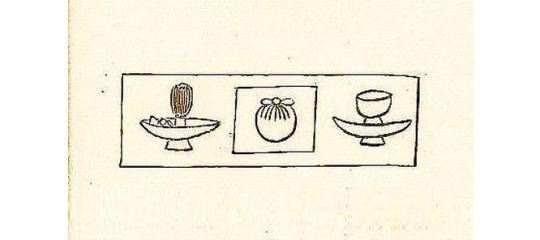
The same sort of arrangement was considered in the post entitled Nampō Roku, Book 5 (13.1): the Arrangement [of the Daisu] During the Shoza when [Receiving a] Respected Guest, Part 1. The URL for that post is:
https://chanoyu-to-wa.tumblr.com/post/620572177833623553/namp%C5%8D-roku-book-5-131-the-arrangement-of
That said, Shibayama Fugen relates that his source (who was one of the original group of Enkaku-ji scholars, who passed these teachings on to Shibayama in his old age -- apparently because there was no one left at the Enkaku-ji who was interested in learning such things) explained mitsu-gumi as meaning that the chawan and chaire are displayed on the mat in front of the mizusashi. This appears to be an explanation related to the sōan -- though that interpretation seems irrelevant in this context (especially because, in Shibayama’s teihon, the passage that discusses the display of the hitotsu-mono in the sōan was segregated into a separate entry).
‡Tamaeri [玉えり]: the kanji tama [玉] should be understood as a hentai-gana, representing the sounds tama [たま].
**Perhaps that is why the reader is cautioned not to confuse the two arrangements.
⁹Hitotsu-mono no kazari meibutsu nado, waga-dōgu to te iyashimi ni oyobazu [一物ノカザリ名物等、我道具トテ卑下ニ不及].
Waga-dōgu [我道具] means ones own utensil.
Iyashimi ni [卑下に] means to handle or regard something as insignificant, to deprecate*.
Oyobazu [及ばず] means unnecessary, not to do (something).
As mentioned above, in both Shibayama Fugen’s and Tanaka Senshō’s teihon [底本], the remainder of this section is treated as a separate entry. __________ *In terms of kane-wari, this would mean to orient the object so that it overlaps its kane by one-third.
¹⁰Kane no mannaka, mine-suri ni oku-beki nari [カネノ眞中、峯摺ニヲクベキ也].
Kane no mannaka [カネの眞ん中] means “the exact center of the kane.”
Mine-suri ni oku-beki [峰摺りに置くべき]: mine-suri [峰摺り] means “to rub against the peak” -- that is, an object is displayed so that its center “approaches” (i.e., is displaced ever so slightly from) the exact center of the kane with which it is associated*. The device is usually employed as a way to deprecate ones own meibutsu utensil. __________ *Mine-suri placement is usually associated with one of the three central yang-kane, and was a consequence of these kane being derived from the 3-bu-wide folds of the shiki-shi [敷き紙] (allowing the center of the utensil to deviate slightly from the very center of the kane while still being fully “on” the kane).
¹¹Suri to ha, kane no mannaka wo dōgu no mannaka ni sukoshi zura-suru nari [スリトハ、カネノ眞中ヲ道具ノ眞中ニ少スラスルナリ].
Sukoshi zura-suru [少しずらする] means “to gradually slide something (toward another thing).”
That is, the object should be positioned carefully so that it is almost perceptibly off-center.
¹²Naka-naka me ni miyuru-hodo no koto ni te nakere-domo, kore hiji-kuden nari [中〰目ニ見ユルホドノ事ニテナケレドモ、コレ秘事口傳ナリ].
Me ni miyuru-hodo ni [目に見ゆるほどに]* means appreciably; “so as to be visible.”
Nakere-domo [なけれども] means “even if (it is obvious to the naked eye), nevertheless (orienting it intentionally in this way is a deeply guarded secret).”
Hiji-kuden [秘事口傳] means a secret teaching that should only be transmitted orally†. __________ *In the modern language, it would be me ni mieru-hodo ni [目に見えるほどに].
†In other words, the perfect alignment of the utensil with the kane, even though it is easily taken note of, is, itself, the secret teaching. (Generally, such teachings are notably less than apparent, or less than obvious. As a result, many might be tempted to underestimate the importance of this point.)
¹³Migi wo suri, hidari wo suru-koto shisai aru-koto nari [右ヲスリ、左ヲスルコト子細アルコトナリ].
Shisai [子細] means reasons, circumstances, details, particulars.
In other words, the direction in which the utensil is displaced depends on things like the size of the various utensils*, the orientation of the room (with displacing it slightly away from the guests† being preferred), and so on. These are the things alluded to by shisai. __________ *The direction will depend on how close the neighboring utensils approach. Remember, though, that this displacement is so slight that it is almost unnoticeable.
†When the guests are seated on the host's right, the preferred displacement would be toward them, as a consequence of the inversion of the room while the things on the daisu retain their original configurations.
¹⁴Tsune no dōgu, suri-gane to iu-koto ha nashi [常ノ道具、スリガネト云コトハナシ].
Tsune no dōgu [常の道具] means ordinary utensils; common or non-meibutsu utensils.
Suri-gane to iu-koto [摺りガネと云うこと] means “what we refer to as ‘rubbing against the kane....’”
¹⁵Sōan ni koma-goma no kane ginmi ni mo oyobazu-yō nare-domo [草菴ニコマ〰ノカネ吟味ニモ不及ヤウナレドモ].
Koma-goma [細々] means minutely, in detail.
Ginmi [吟味] means to examine, to investigate.
Oyobazu-yō [不及よう = 及ばずよう] means unnecessary to do (something).
Nare-domo [なれども] means but, however, even if, though.
¹⁶Hitotsu-mono nado ha komayaka ni kanben-subeshi [一物ナドハコマヤカニ勘辨スベシ].
Komayaka ni [細かに] means to inspect (something) carefully.
Kanben-subeshi [勘辨すべし] means (we) should be tolerant (of doing that).
In other words, since hitotsu-mono orientation is used only in the case of extremely important utensils, when such things are used in the sōan*, everyone should respect the rules of correct placement. __________ *Technically, such things should really not be used in the sōan. Nevertheless, if the host owns such a utensil, there is no reason he should not use it -- if he has a special reason for wishing to do so.
¹⁷Shikaru yue ni tsune-no-dōgu mo somatsu ni oki-soroeba hitotsu-mono no yō ni oke-nasu nari [シカルユヘニ常ノ道具モ麁末ニ置候ヘバ一物ノヤウニ置ナス也].
Somatsu [麁末 = 粗末] means crude, coarse, rough -- and so acting in such a manner, negligently.
¹⁸Tan-ren kan-yō no koto nari [煆煉肝要ノコト也].
Tan-ren [煆煉 = 鍛練] means discipline, training.
Kan-yō no koto [肝要のこと] means something that is crucial, imperative, indispensable.
1 note
·
View note